More than 77% of businesses use social media marketing to connect with customers— yet only a few succeed in creating truly impactful campaigns that come to mind when reflecting on memorable brand experiences.
The key to success lies in the innovation, detailed research, and effective execution of your social media campaigns. To truly stand out, you need to engage your audience by aligning with their interests and values.
Implementing an innovative social media strategy involves leveraging data-driven insights to create content that attracts and resonates with your target audience.
This article will help you create social media marketing campaigns that stand out and leave a mark on your audience’s minds.
Table of contents
What is a social media campaign?
How to develop a social media campaign strategy?
How to run a social media marketing campaign?
10 Tips for creating a successful social media campaign
Examples of creative social media campaigns
What is a social media campaign?
A social media campaign is a key component of an omnichannel marketing strategy, focusing on achieving specific social media goals like increasing brand awareness or improving engagement rates. It involves coordinating efforts across one or more platforms to promote a business or product.
When creating a social media campaign, aligning it strategically with company objectives is important.
Effective social campaign management typically integrates various elements such as organic posts, paid promotions, contests, branded hashtags, user-generated content, and collaborations with creators or influencers.
Understanding how to run a campaign successfully can significantly impact its outcomes and contribute to the broader marketing strategy.
How to develop a social media campaign strategy?
Before you dig into starting your campaign, you need to do ample research and then come up with a strategy that would work. Here’s how to develop a viral social media campaign.
Establish your goals for your social media campaign
Just like any other marketing initiative, to create a social media campaign strategy, start by defining your campaign's goal.
Whether it's increasing brand awareness, boosting engagement, driving traffic, or generating sales, a clear objective will guide your content, targeting, and measurement efforts. This ensures your strategy is focused and aligned with your business objectives, making it easier to track and optimize performance.
Define your target audience
To reach the right set of audience, you need to first know who the right audience is. This is why you need to define your target audience.
Understanding your audience's demographics, interests, and behaviors is crucial for successful social campaigns.
Start by identifying key characteristics such as age, gender, location, occupation, and income level.
Then, delve into psychographics to uncover their values, lifestyle, hobbies, and purchasing behavior. This approach will help you craft effective campaign strategies and develop creative digital campaigns that resonate with your audience.
Creating detailed buyer social media personas can help you visualize and empathize with your target audience, enabling you to craft messages and content that resonate deeply with them.
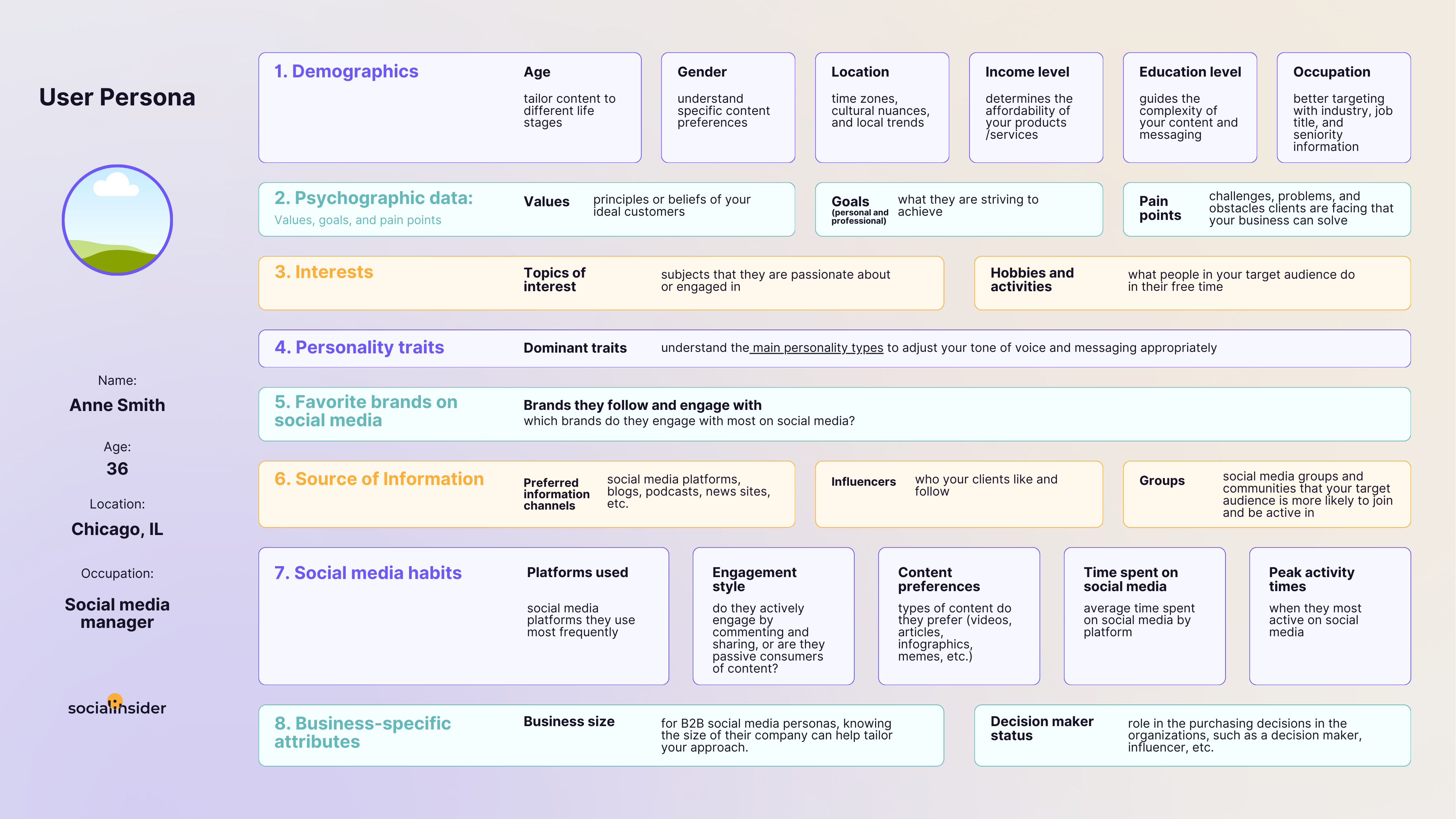
Additionally, leveraging data from analytics tools and social media insights can provide a clearer picture of who is already engaging with your content and who might be interested but hasn't connected yet.
Once you have a well-defined target audience, you can tailor your marketing campaign strategy to meet your potential customers’ specific needs, pain points, and desires. This way, you will ensure that your campaigns are more focused, effective, and ultimately, successful in achieving better social media ROI.
Do a competitive analysis
A thorough social media competitor analysis reveals various competitive insights like what initiatives your competitors have launched and which were most successful, helping you identify market gaps and opportunities.
Start by identifying your direct and indirect competitors. Analyze their marketing campaigns, product launches, and customer engagement tactics. Focus on the channels they use, their messaging, and their campaign outcomes. Tools like social media monitoring and industry reports can provide valuable data on their performance.
Pay attention to key metrics like engagement rates and conversion rates to determine what made certain initiatives successful. Also, take note of their failures to avoid similar pitfalls.
A competitive analysis isn’t about copying—it's about learning from the industry and applying insights to create strategies that set you apart.
Choose the right platforms
Your brand doesn’t need to be active on every social media platform, especially if you’re working under a budget. Instead, focus on the platforms where your target audience spends the most time.
For example, B2B vs. B2C marketing often dictates platform choice—B2B companies may find more success on LinkedIn, where professional networking and social selling thrive, while B2C brands might focus on Instagram or Facebook, where visual content and consumer engagement are more prominent.
Strategically selecting the right platforms will help you maximize your impact and ensure that your great marketing campaigns resonate with your audience.
When creating a marketing campaign, consider social media campaign ideas that align with your audience’s preferences and behaviors.
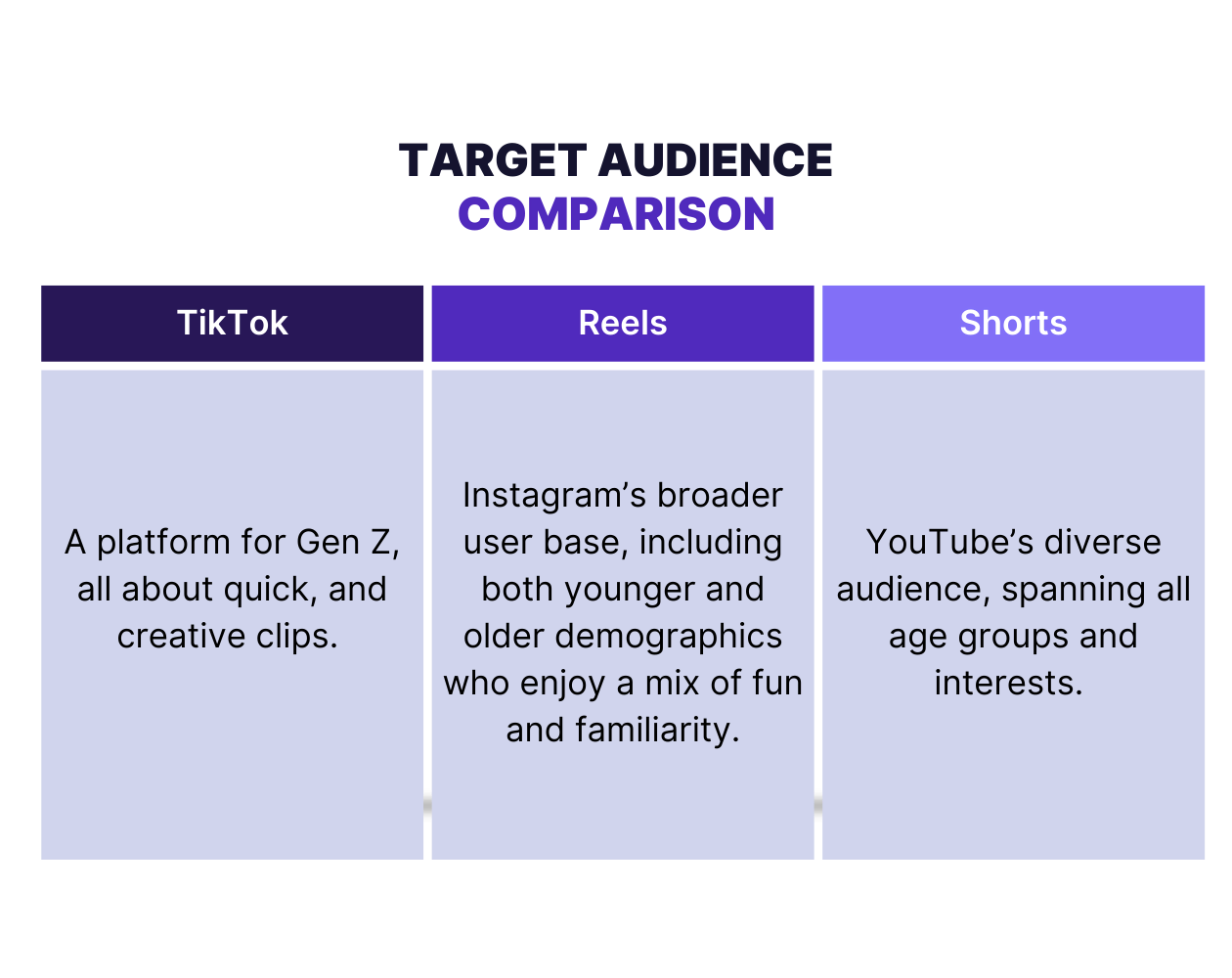
Create a schedule
Determine how long the campaign will run, which can vary depending on your goals, budget, and the nature of your audience.
Whether we’re talking about short-term promotional campaigns or long-term branding campaigns, having a defined timeline helps plan content, set milestones, and measure progress.
Consider breaking down the campaign into phases, such as pre-launch, launch, and post-launch activities. This will allow you to allocate resources effectively and maintain momentum throughout your social campaigns.
Also, setting specific start and end dates for your social media initiatives enables you to create a sense of urgency and anticipation among your audience, driving engagement and ensuring that your efforts align with broader business objectives.
Start implementation
Once your social media campaign plan is in place, it's time to move into the implementation phase. This step involves coordinating with all departments and collaborators to bring the social activation to life.
Effective communication and collaboration are key to ensuring everyone is aligned with the campaign objectives, whether you're working with designers, influencers, or other stakeholders.
Begin by distributing briefs to all involved parties, clearly outlining their roles, responsibilities, and deadlines. For designers, this might include finalizing visuals, graphics, and layouts.
Suppose influencer marketing campaigns are part of your strategy. In that case, you'll need to arrange appointments for content creation, such as photo or video shoots, and ensure they understand the messaging and goals of the campaign.
Throughout the implementation phase, maintain regular check-ins and provide any necessary support to keep the campaign on track. This coordinated effort ensures that all elements of your marketing campaigns are executed smoothly, ultimately leading to a cohesive and impactful social media presence.
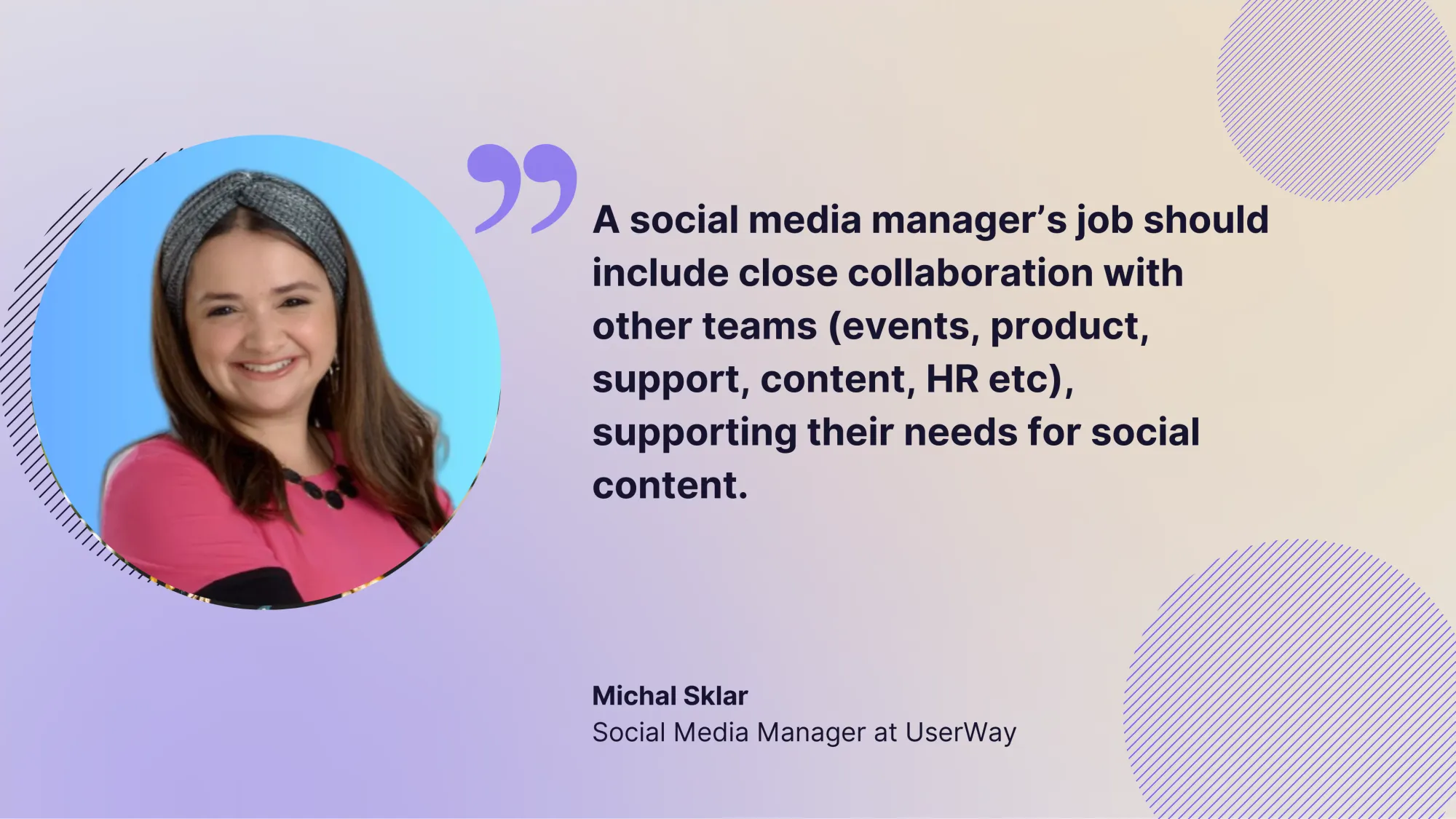
Analyze campaign performance
Evaluating your campaign’s performance helps you understand its impact and refine future strategies. This process involves three critical stages:
- Pre-Campaign Analysis: Review data from past campaigns and industry benchmarks before launching. This helps you set realistic objectives and projections, ensuring your strategy is grounded in proven tactics.
- Mid-Campaign Analysis: Monitor the campaign in real-time to assess progress and make necessary adjustments. This enables you to tweak messaging, resource allocation, or timing as needed, keeping the campaign on track.
- Post-Campaign Analysis: After the campaign ends, compare results with your initial goals. Evaluate key metrics like engagement, conversions, and ROI to measure success and gather insights for future social media activations.
Consistent social media analysis throughout these stages is vital as it helps in making data-driven decisions and optimizing your campaign's effectiveness.
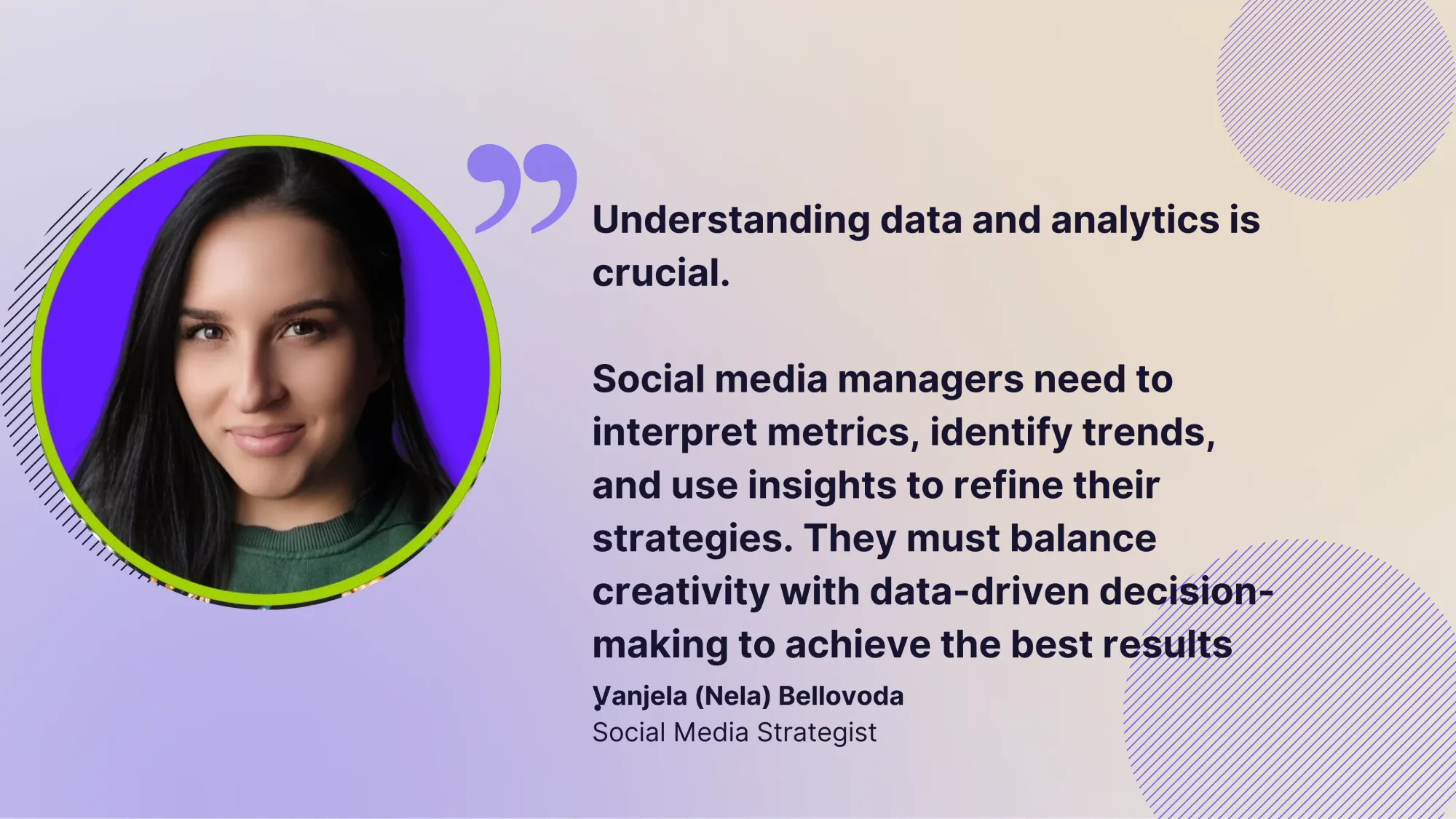
How to run a social media marketing campaign?
Start by brainstorming campaign ideas
The foundation of a successful social media marketing campaign begins with a focused brainstorming session. Generate ideas by involving your team and other departments, asking key questions like:
- What are the challenges our customers face and how do we solve them?
- What do we want to accomplish with this social media campaign?
- Which past campaigns were successful, and what can we learn from them?
When brainstorming ideas, you also need to collaborate with other teams outside of social media, such as product, sales, and customer service, to gain a complete understanding of your customers, products, and competitors. Their insights can inform and improve your campaign, making it more relevant and audience-driven.
Once you've gathered ideas, evaluate them based on feasibility, alignment with objectives, and potential impact, narrowing down to the best concepts for execution.
Create a content calendar
A well-planned content calendar helps you organize and schedule posts across platforms, ensuring a strategic approach.
However, posting the same content simultaneously on every platform can lead to audience fatigue and reduce your brand’s appeal. Instead, tailor content to each platform's unique audience and characteristics.
For example, Instagram suits visually-driven content, while LinkedIn is ideal for thought leadership pieces. Stagger posts to keep engagement high and your audience interested.
In your content calendar, include a mix of content types—images, videos, polls, and user-generated content—to keep your campaign dynamic.
Collaborating with influencers can also help create authentic content that resonates and expands your social media reach. Ultimately, diversity ensures your messaging remains fresh and relevant.
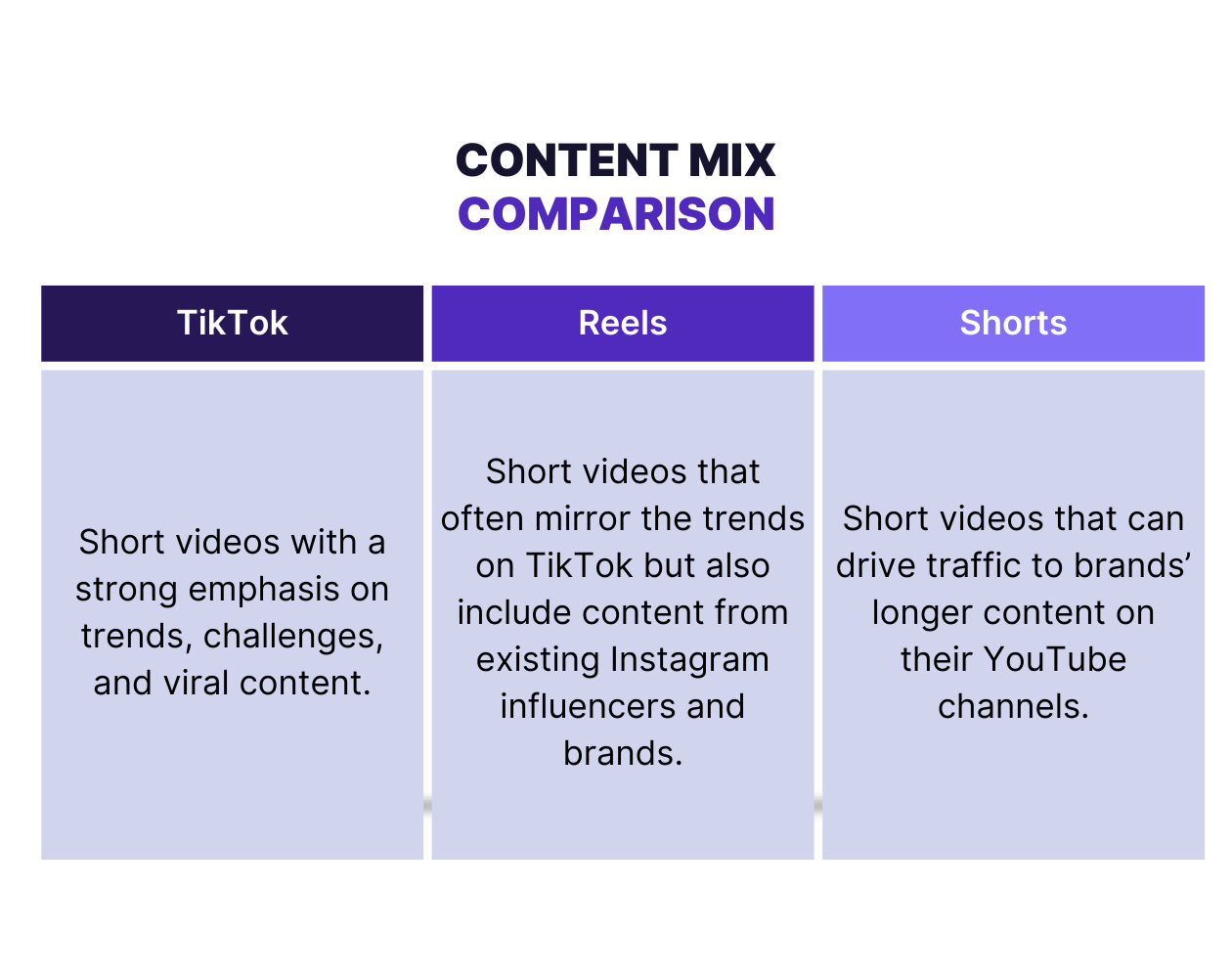
Pro Tip: Tailor your content to the specific stage of the buyer’s journey. In the consideration stage, for instance, focus on providing valuable insights through comparison guides, product demos, or customer testimonials to help potential customers make informed decisions and move closer to a purchase.
Craft the creatives
Consider this: social media users are constantly flooded with content. So, how can your content stand out?
This is where the power of creatives comes in.
Creatives are what bring your social media posts to life, making them not just visible, but memorable. They add the visual and emotional appeal needed to capture attention and engage your audience amidst the noise.
But it’s not just about having a great concept; it’s about adapting that concept to fit the unique strengths and preferences of each platform you’re using.
Different platforms have different best-performing content types, so it’s essential to tailor your creatives accordingly.
For example, on Instagram, Reels tend to perform best, as they capture attention quickly and encourage engagement through short, visually appealing videos.
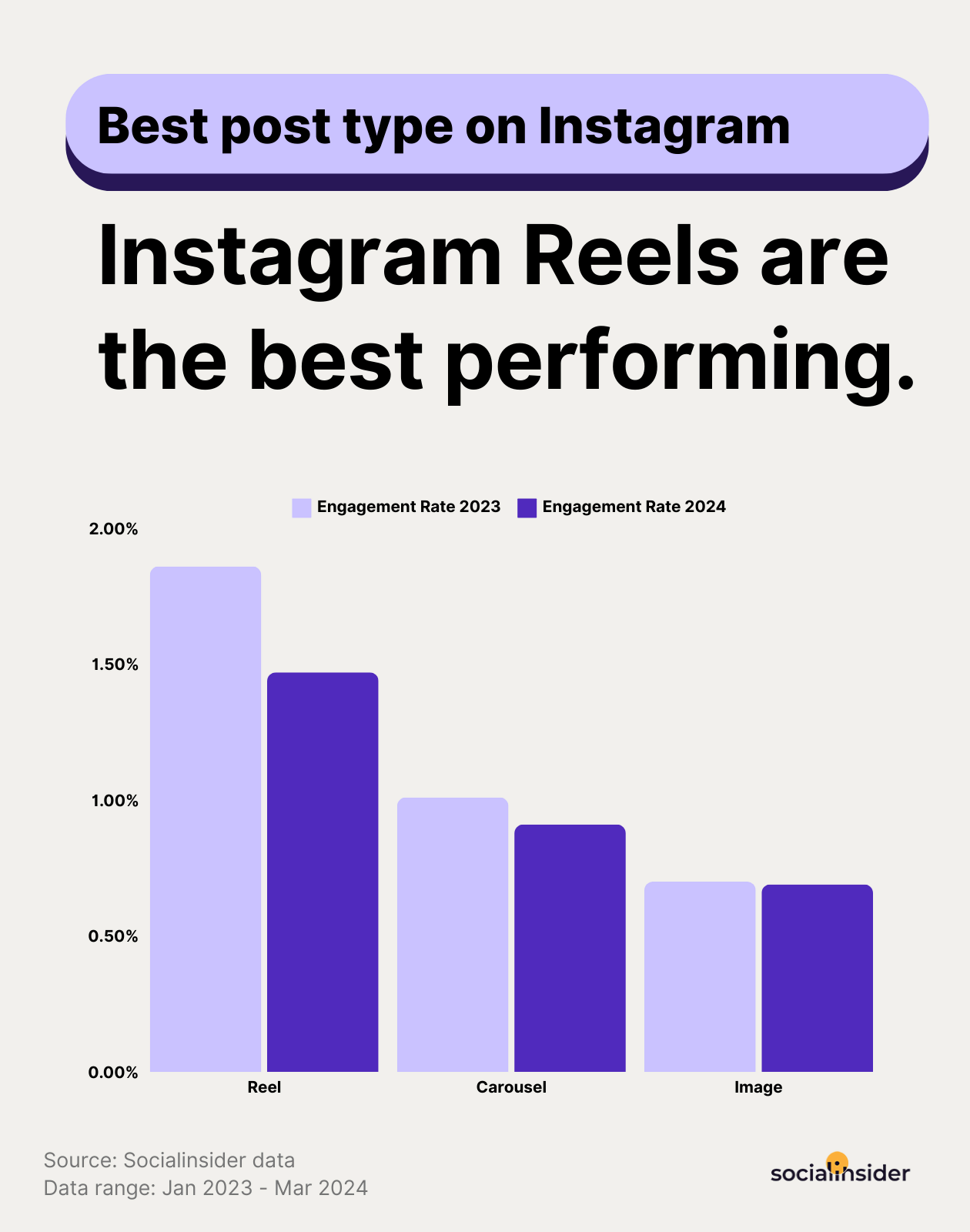
On Facebook, videos are also highly effective, especially those that tell a compelling story or provide valuable information in a concise format.
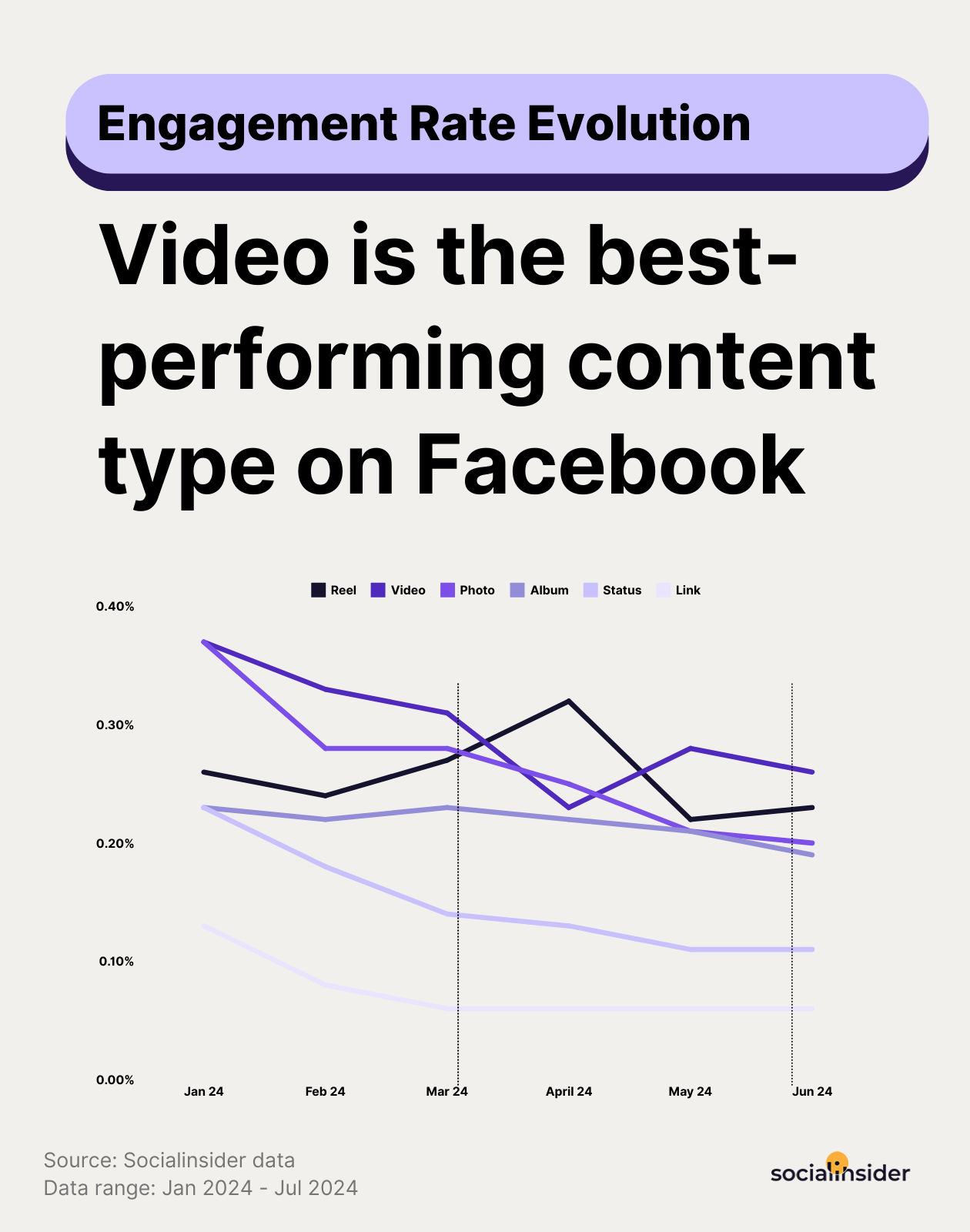
Meanwhile, on LinkedIn, multi-image posts and carousel posts often drive higher engagement, as they allow for more detailed storytelling and showcase a series of ideas or products in a single post.
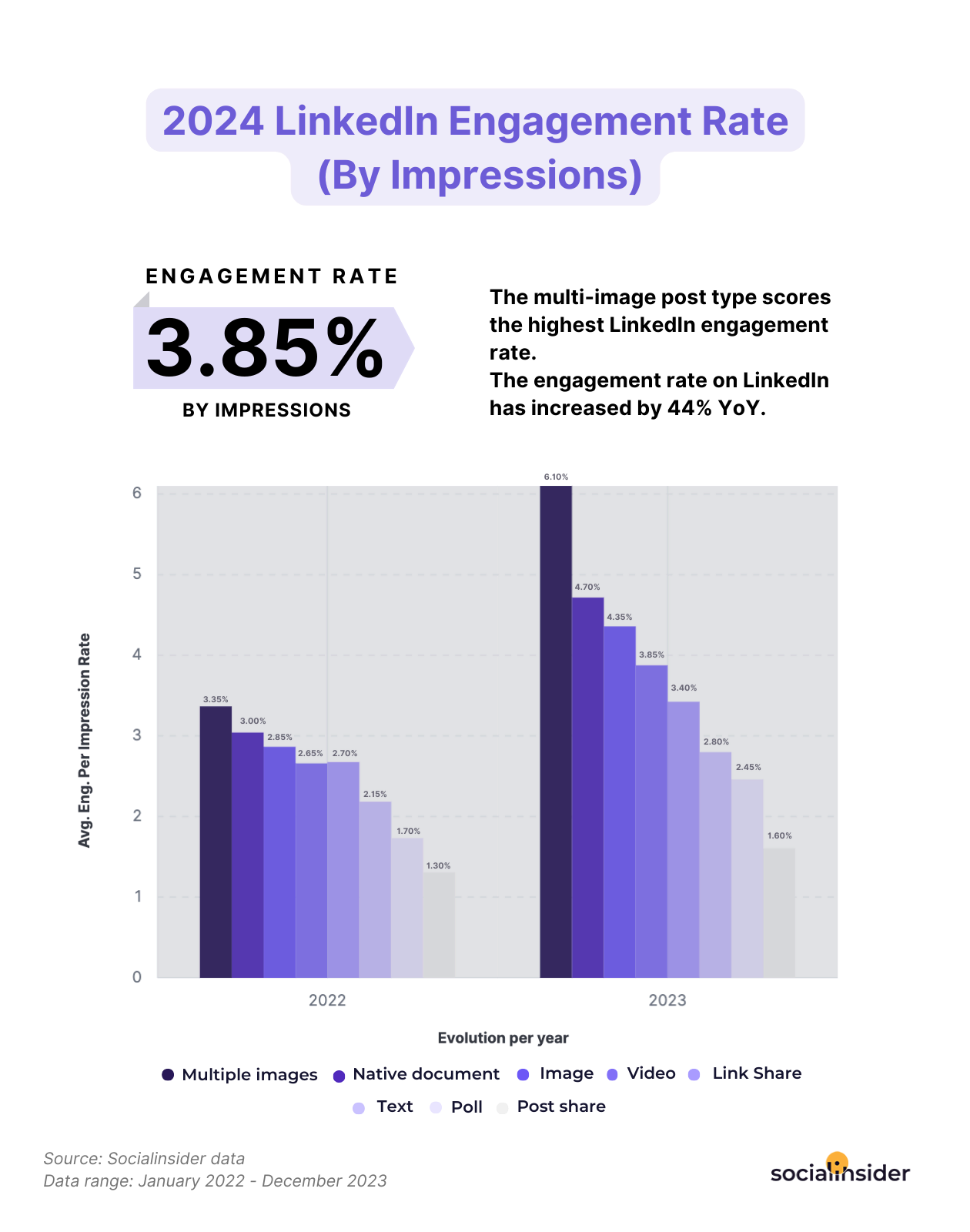
When crafting your creatives, consider what has historically performed well on each platform and adapt your campaign’s concepts to align with those content types. This approach not only maximizes engagement but also ensures that your content resonates with the specific audiences you’re targeting on each platform.
Monitor campaign KPIs
Monitoring the right Key Performance Indicators (KPIs) is essential for evaluating the success of your social media campaign. The first step is to choose KPIs that align with your campaign’s goals.
For instance, if your primary objective is brand awareness, metrics like reach and impressions should be your top focus. These metrics give you insight into how many people are seeing your content and how often.
For a more comprehensive analysis, consider tracking additional social media metrics such as engagement (likes, comments, shares), click-through rate (CTR), and follower growth.
Monitoring these emtrics will help you understand how your audience is interacting with your content and whether your campaign is driving meaningful actions.
To simplify and improve your campaign measurement, social media analytics tools like Socialinsider can be invaluable.
With Socialinsider, you can tag posts related to a specific campaign, making it easier to view all associated posts and data in one place. This feature allows you to efficiently monitor performance, compare results across different posts, and get insights that can inform future campaigns.
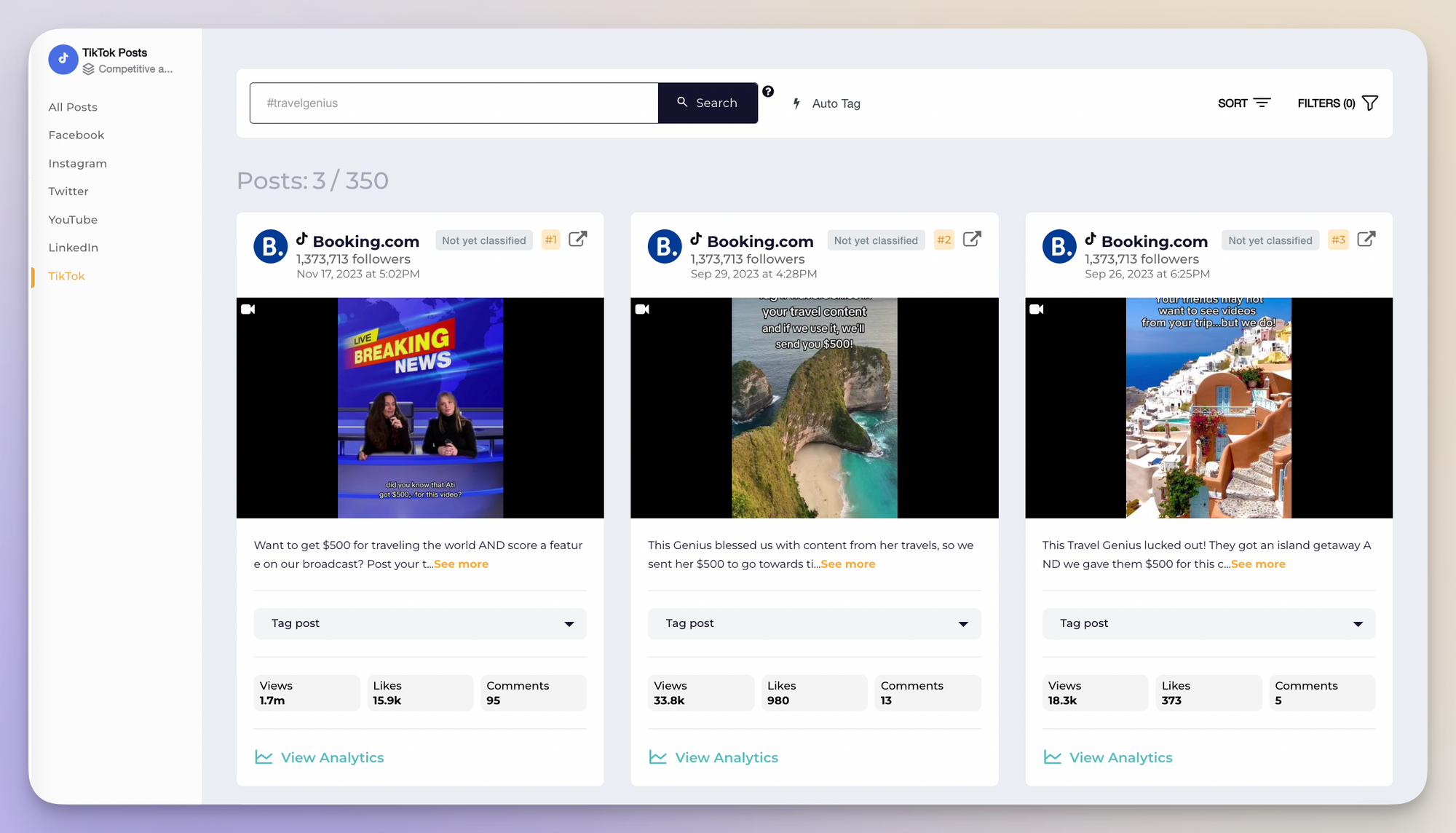
10 Tips for creating a successful social media campaign
Now that you know how to create a social media campaign, here are some tips to help you develop a “successful” social media campaign. Let’s go!
#1. Gather customer insights
The idea behind any digital marketing campaign is to reach your target audience and turn them into customers. And who better than your current customers can help you understand what resonates most with your audience?
Collecting insights from your existing customers—through surveys, feedback, or social listening—will help you refine your social media campaign strategy, tailor your messaging, and create content that speaks directly to the needs and preferences of your target audience.
Such an approach will not only increase the effectiveness of your campaign but also build stronger relationships with your customers by showing that you value their input.
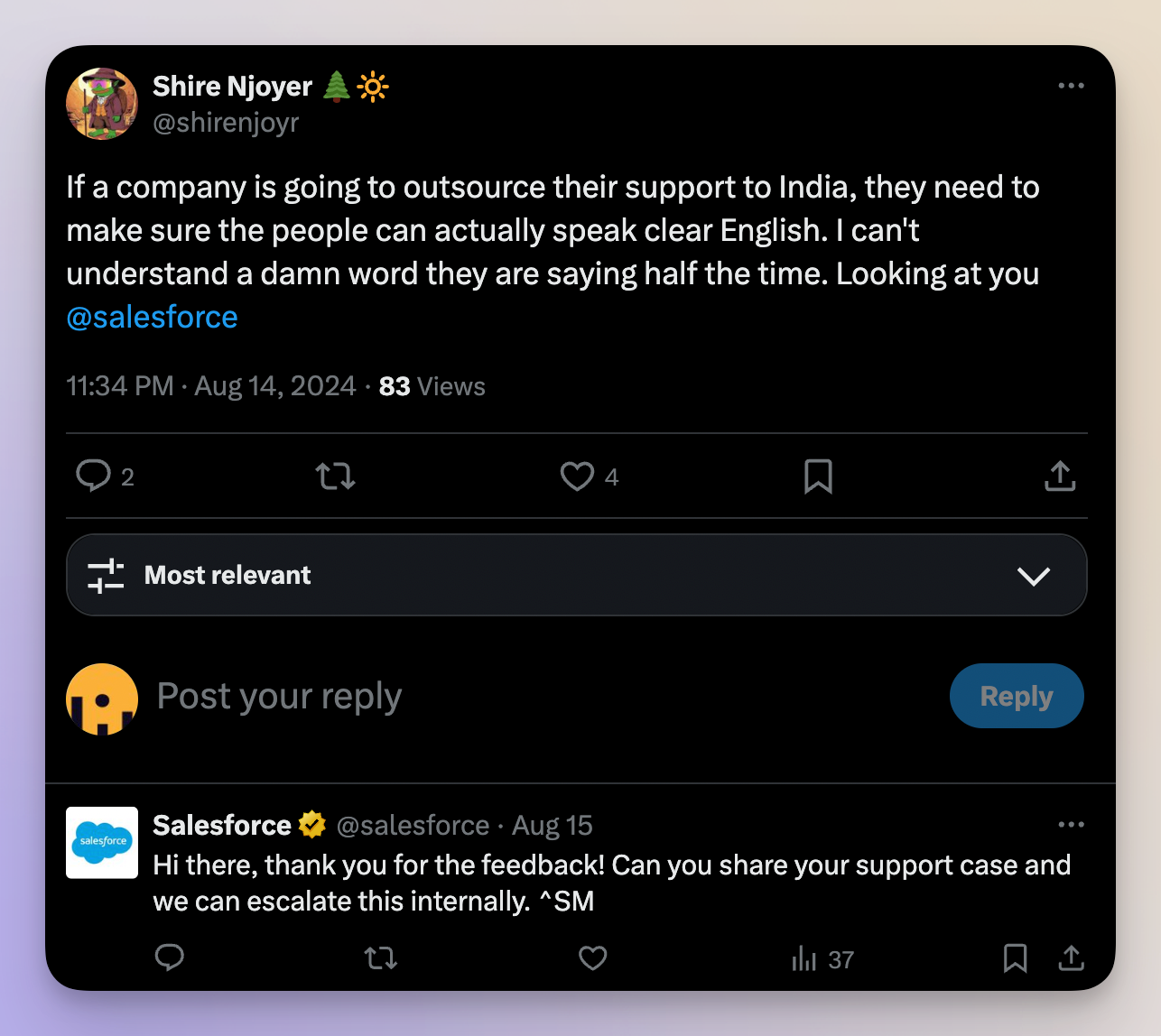
For example, Salesforce, a global leader in customer relationship management (CRM) solutions, is known for its proactive social media strategy, particularly on Twitter.
Salesforce actively monitors its mentions and engages directly with customers, prospects, and the broader community.
By responding to nearly every mention—whether it’s a question, feedback, or even a complaint—Salesforce gathers valuable insights into what its users care about most.
For instance, if a customer asks for help with integrating a Salesforce feature or troubleshooting an issue, Salesforce quickly responds with personalized guidance, links to relevant resources, or directs them to the right support channels.
Through this strategy, Salesforce not only resolves the customer’s immediate concerns but also gets the chance to identify common pain points.
#2. Leverage partnerships
69% of consumers trust influencer recommendations for new products or services, making influencer marketing a powerful tool for brands.
However, before selecting influencers for your campaigns on social media, it's essential to evaluate key metrics such as their engagement rate, audience demographics, authenticity, and alignment with your brand values.
Ensure that the influencer’s followers match your target audience in terms of interests, age, and location.
Also, when leveraging influencer marketing trends, don’t limit yourself to a single post or video marketing ideas.
Instead, plan a series of content pieces that build momentum and deepen the connection with the influencer’s audience over time, maximizing the impact and reach of your social activations.
For example, Daniel Wellington, the watch brand, effectively uses influencer marketing by partnering with micro and macro-influencers across different regions.
They don't just stop at a single post; instead, they collaborate on a series of posts and videos, often incorporating discount codes and giveaways. This approach has helped Daniel Wellington build brand awareness and drive sales, particularly among younger audiences.
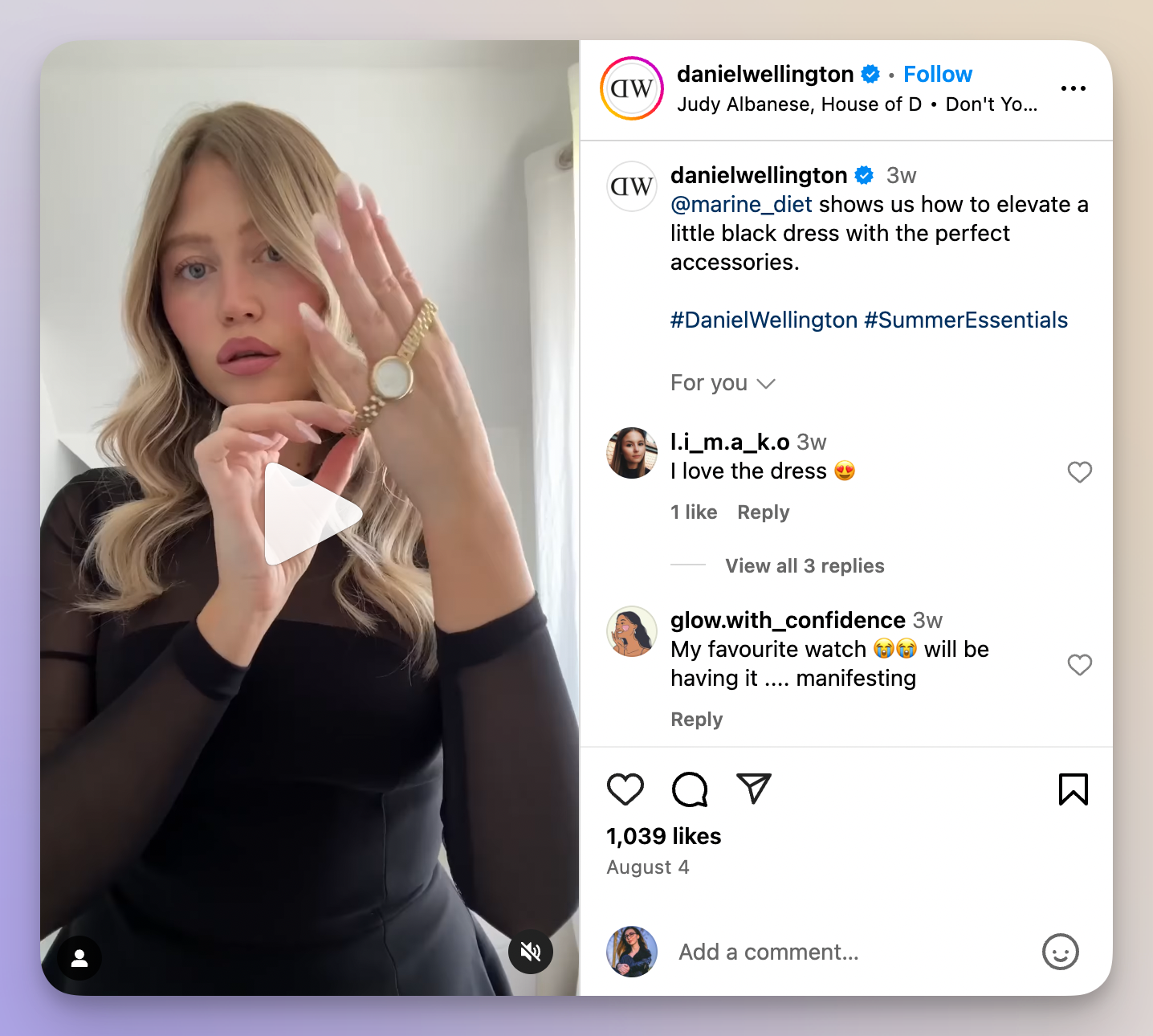
Moreover, collaborations between brands can be a powerful strategy to tap into new audiences.
By joining forces with complementary brands, you can create joint campaigns that leverage each other’s audiences and increase the overall reach.
For instance, when two brands with similar target demographics collaborate on a campaign, it not only amplifies the message but also introduces both brands to new potential customers. This strategy is especially effective when developing a social media campaign, as it can significantly enhance visibility and engagement.
For example, the Adidas x Gucci collaboration in 2023 represents a perfect blend of sportswear and high fashion, bringing together Adidas' iconic athletic aesthetics with Gucci's luxury and style.
The partnership resulted in a distinctive collection that includes sneakers, apparel, and accessories, each piece reflecting the unique design philosophies of both brands.
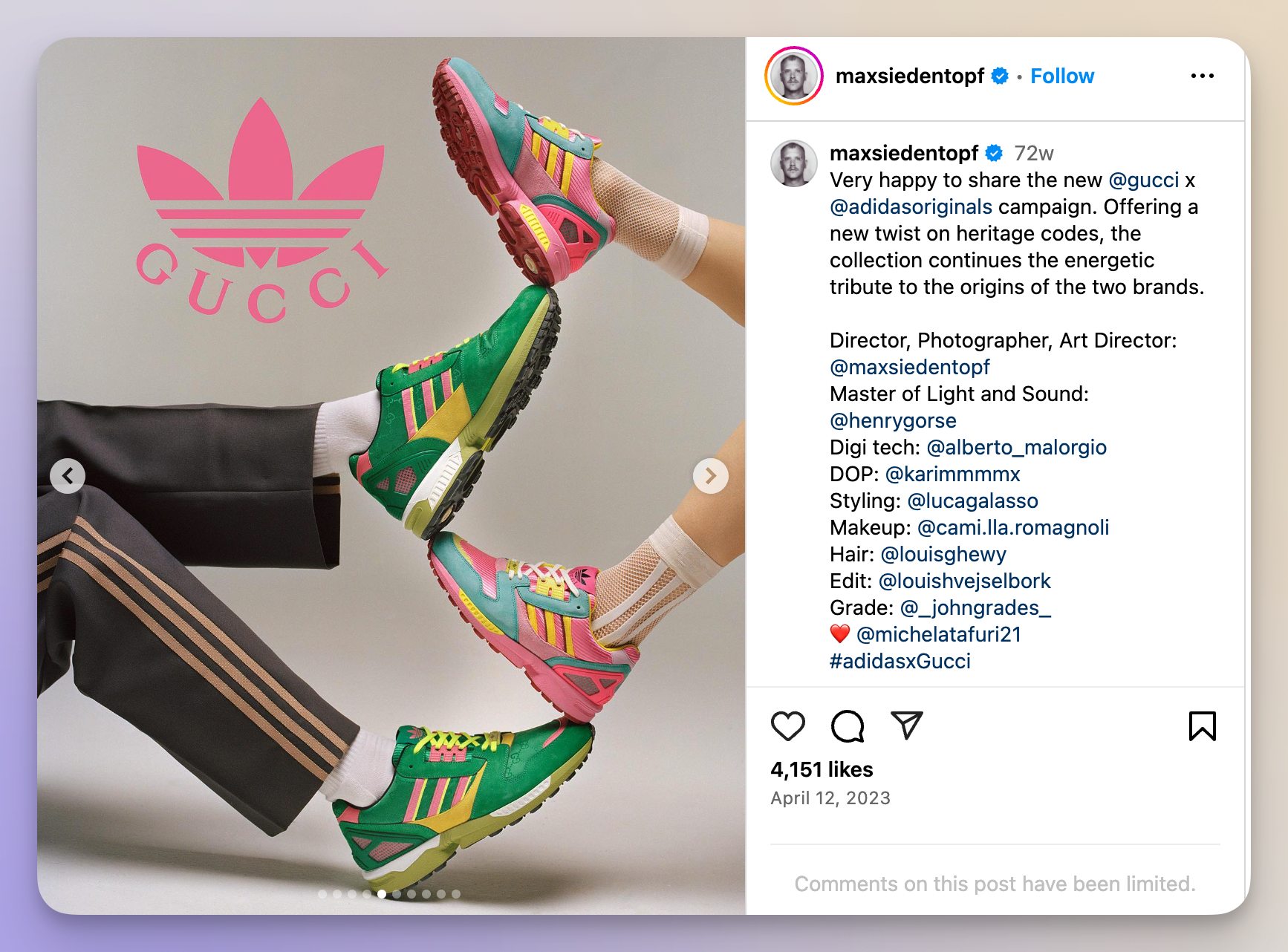
Such successful campaigns demonstrate the impact of strategic partnerships, making them excellent campaign examples for brands looking to expand their reach and achieve higher levels of success.
The collaboration resonated with a wide audience, appealing to both streetwear enthusiasts and luxury fashion lovers.
Merging these two worlds helped Adidas and Gucci create a line that not only made a statement in the fashion industry but also showcased the power of brand synergy in creating innovative and desirable products.
#3. Hop on trends
Leveraging current social media trends can amplify your brand's visibility, but the key is to align these trends with your brand's identity.
For example, Jacquemus effectively tapped into the excitement surrounding the 2024 Paris Olympic Games by collaborating with Nike.
Their campaign, blending fashion and athletic wear, featured a diverse cast and a short film that resonated with Olympic enthusiasm while staying true to Jacquemus’s innovative style.
In my view, this campaign is a great example of how to use trending events to enhance your brand’s narrative, ensuring that the campaign remains authentic and impactful. Wouldn't you say so?
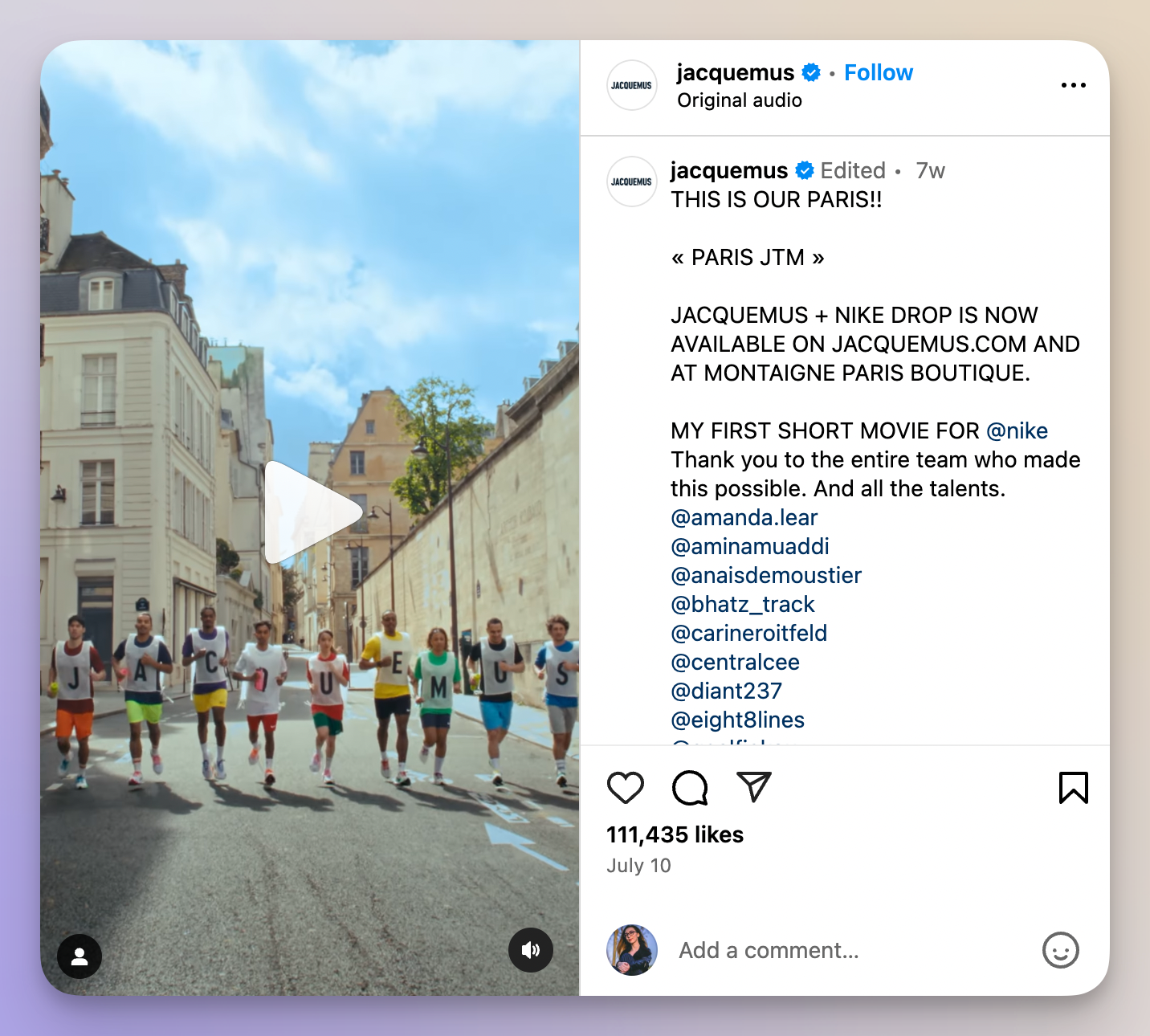
When hopping on trends, always find a way to tie them back to your brand’s core values and messaging, ensuring that your campaign remains authentic and relevant.
#4. Think beyond social
While social media is a powerful tool, thinking beyond it can make your campaigns even more impactful.
Surreal, the cereal brand, is a great example of this approach. They create shareable out-of-home (OOH) advertisements that capture attention in the physical world and encourage social sharing, serving as a brilliant social media activation idea.
The witty, eye-catching ads are designed to stand out in public spaces and prompt people to take photos and share them online, seamlessly bridging the gap between traditional and digital marketing. This strategy is reminiscent of some of the best social media campaigns that effectively integrate offline elements.
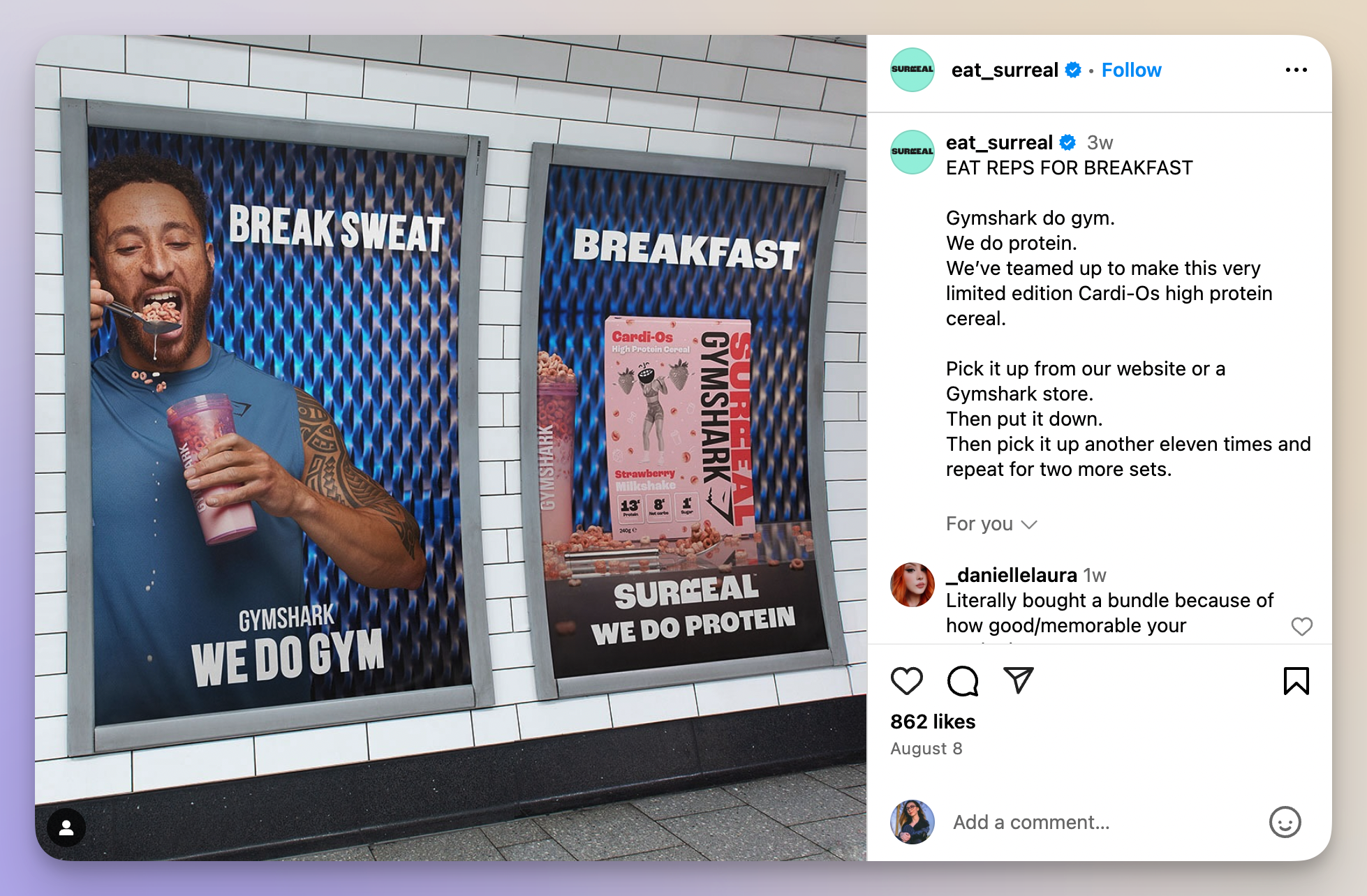
Social media isn’t the only place where your customers are, and there’s immense value in creating campaigns that extend beyond the digital sphere.
By incorporating elements that encourage engagement outside social platforms, such as OOH ads, experiential marketing, or collaborations, you can create a more holistic brand experience.
Such an approach not only broadens your reach but also reinforces your brand’s presence in the everyday lives of your audience, making your campaign more memorable and impactful.
Reflecting on recent social media campaigns, it’s evident that popular social media campaigns often achieve success by integrating these multifaceted strategies.
#5. Inspire on social, close on store
Remember all the social media content around new launches or sales in Zara, H&M, and other brands with physical stores? These brands excel at using famous social media campaigns to create excitement and drive traffic to their physical locations.
Showcasing limited-time offers, exclusive in-store deals, or sneak peeks of new collections on social platforms enables brands to inspire customers to visit the store and make a purchase.
This strategy works because social media is a powerful tool for creating awareness and generating interest, but the final step—closing the sale—often happens in-store. There, customers can experience the products firsthand, benefit from personalized service, and take advantage of in-store promotions.
By running successful campaigns that integrate social media with in-store experiences, brands like Zara and H&M effectively turn online inspiration into offline sales.
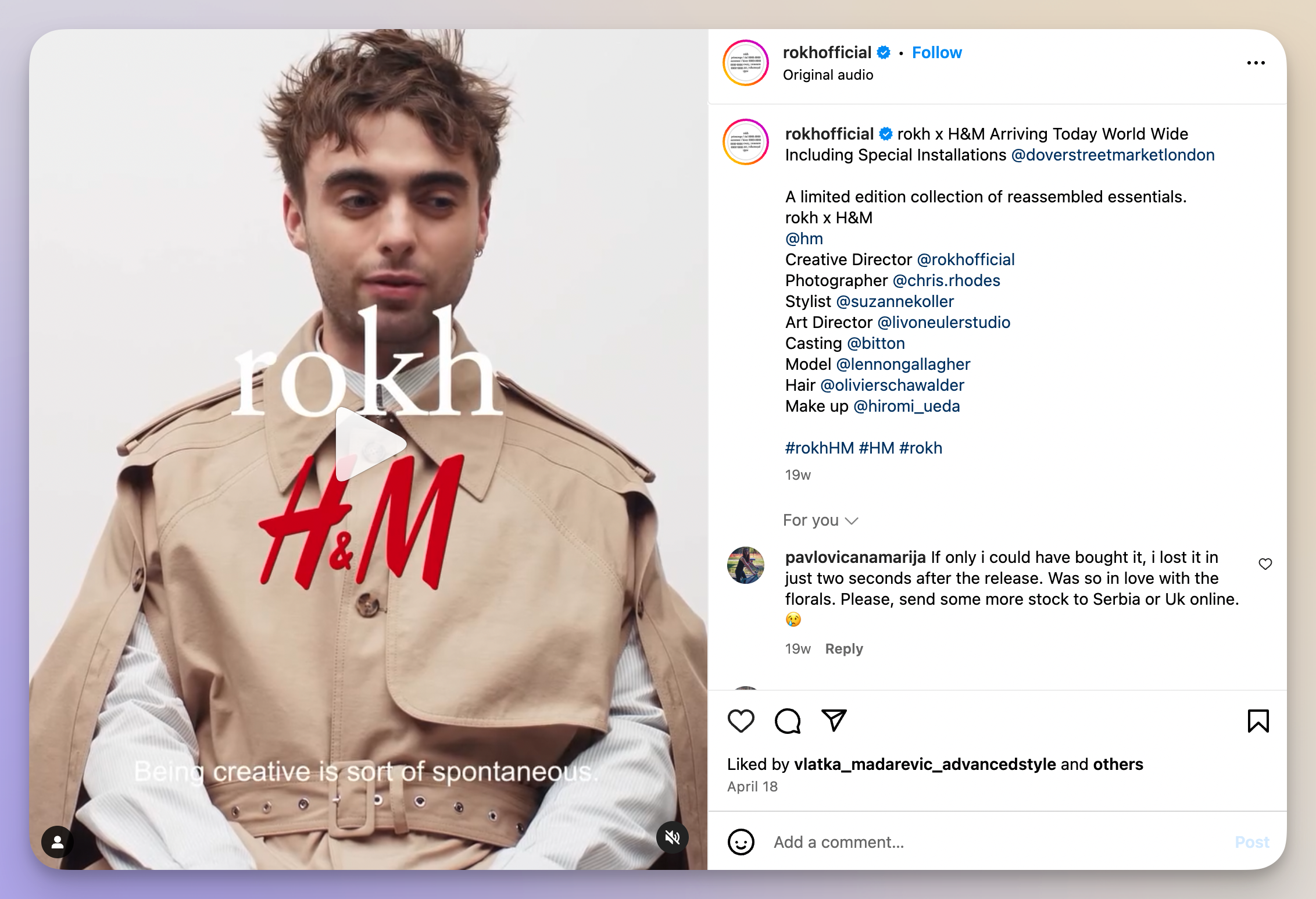
#6. Maintain a consistent customer journey
A seamless customer journey is the backbone of any successful social media campaign and a critical focus for any social media strategist.
It’s essential to guide customers smoothly from the first point of contact to the final purchase, ensuring each step is connected and consistent.
When building a social media campaign, every interaction—from seeing a post on social media to navigating your website—should be aligned, as this builds trust, reduces friction, and enhances the overall experience.
Great social campaigns not only increase the likelihood of conversion but also foster long-term loyalty and advocacy.
For example, consider the importance of mobile optimization within this journey. Imagine a potential customer scrolling through Instagram and encountering a tempting post for your product. If they tap on the link and are directed to a landing page that isn’t optimized for mobile, it can lead to frustration and lost sales.
This breakdown in the journey can make customers feel disconnected from your brand. To avoid this, ensure that every touchpoint—especially those on mobile devices—offers a consistent and user-friendly experience.
Brands like Nike excel at running campaigns by creating mobile-optimized landing pages that mirror the campaign’s visuals and messaging, ensuring that customers can easily continue their journey from interest to conversion without any disruptions.
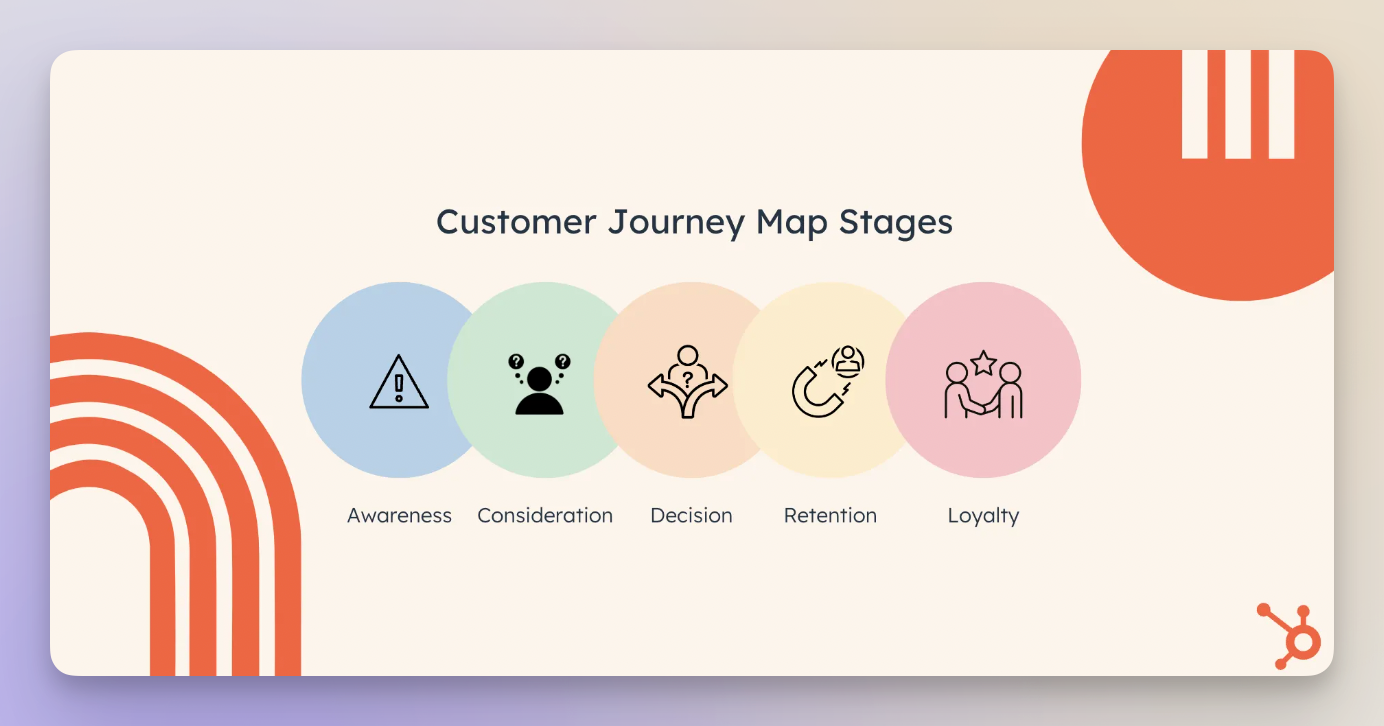
#7. Make your content interactive
To truly engage your audience and make them active participants in your campaign, you need to create interactive content.
Instead of treating your audience as passive spectators, involve them directly in the story of your campaign.
Interactive social media campaigns encourage deeper social media engagement, making your audience feel more connected to your brand and more invested in the campaign’s outcome.
Using interactive elements such as polls, quizzes, contests, and interactive videos is a key aspect of successful campaigns on social media, inviting users to engage with your content rather than just consume it.
For instance, you could create a poll that lets your audience choose the next product launch or a quiz that helps them find the perfect product for their needs. This not only keeps the audience engaged but also provides valuable insights into their preferences and behaviors.
When developing a social media campaign, incorporating these interactive elements becomes an essential part of your social media campaign strategies.
An element of a successful strategy is ensuring that your audience feels directly involved, leading to stronger brand loyalty and better overall results.
For example, Spotify's "Mood Quiz" allowed users to find playlists based on their current mood. This simple yet effective quiz provided personalized results and directly linked users to mood-specific playlists, perfectly aligning with Spotify’s tagline, “Music for every mood.”
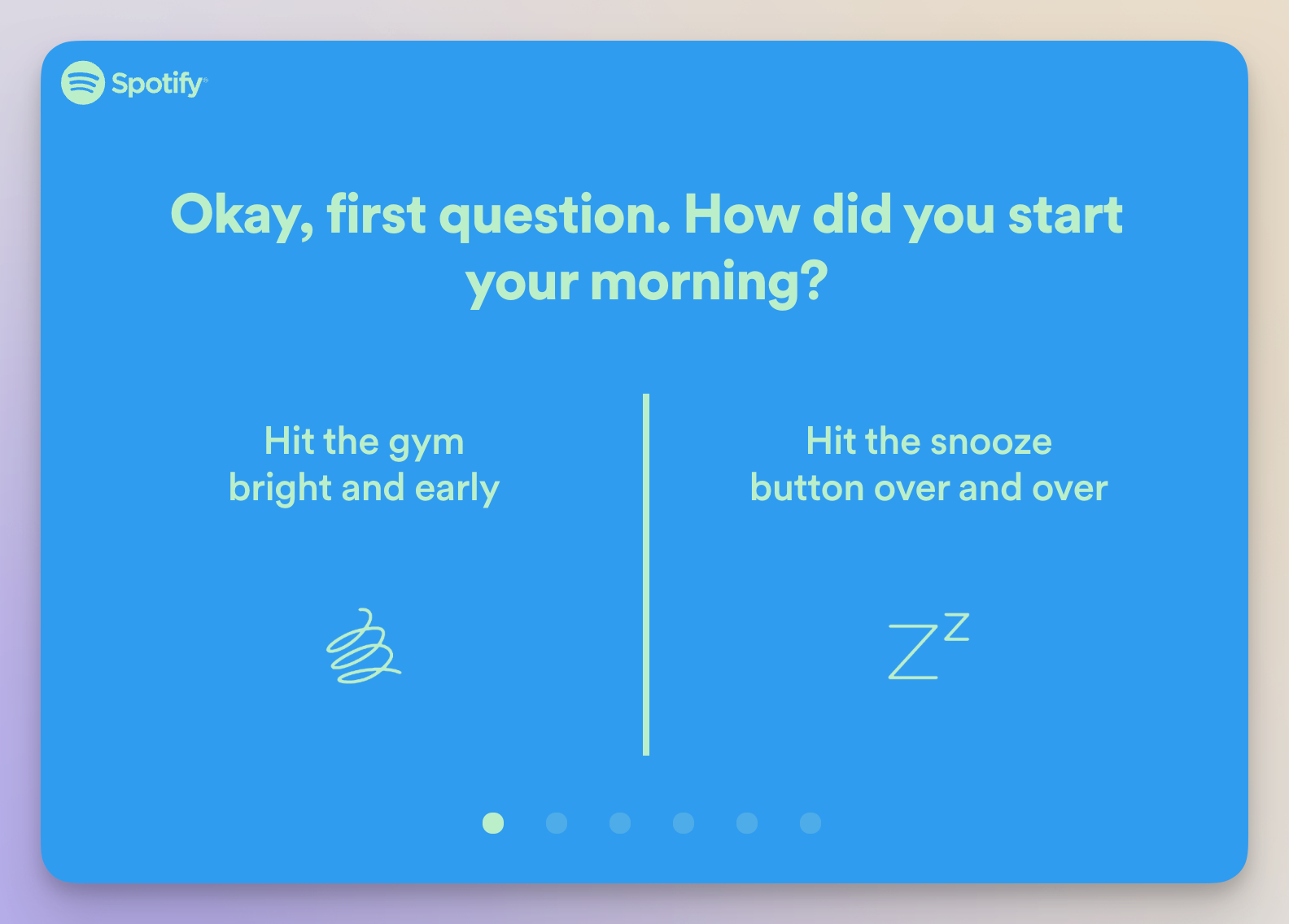
#8. Spark an emotion
Content that evokes emotion is far more likely to leave a lasting impression on your audience.
Whether it’s joy, empathy, nostalgia, or excitement, tapping into your audience’s emotions helps create a deeper connection with your brand. This approach is evident in some of the most successful social media campaigns, where emotional content not only captures attention but also encourages sharing, as people are more likely to engage with and spread content that resonates with them on a personal level.
When developing a social media campaign, it’s essential to consider how to incorporate emotional triggers as part of your campaign tactics.
For example, a campaign that tells a heartfelt story or evokes a sense of nostalgia can be a powerful tool in your creative digital campaigns. An example of a campaign that successfully leverages emotion can serve as a blueprint for your own efforts, ensuring that your content not only reaches but also deeply resonates with your target audience.
For example, in 2023, Disney launched the "Disney100" campaign to celebrate its 100th anniversary. This campaign was a masterclass in using emotion to connect with audiences across generations. Disney released a series of nostalgic videos and social media posts that highlighted iconic moments from its movies, TV shows, and theme parks, evoking feelings of nostalgia, joy, and wonder.
The campaign also included fan engagement elements, like encouraging people to share their own Disney memories on social media using the hashtag #Disney100. This user-generated content campaign created a sense of community and belonging, as fans reminisced about the impact Disney had on their lives.
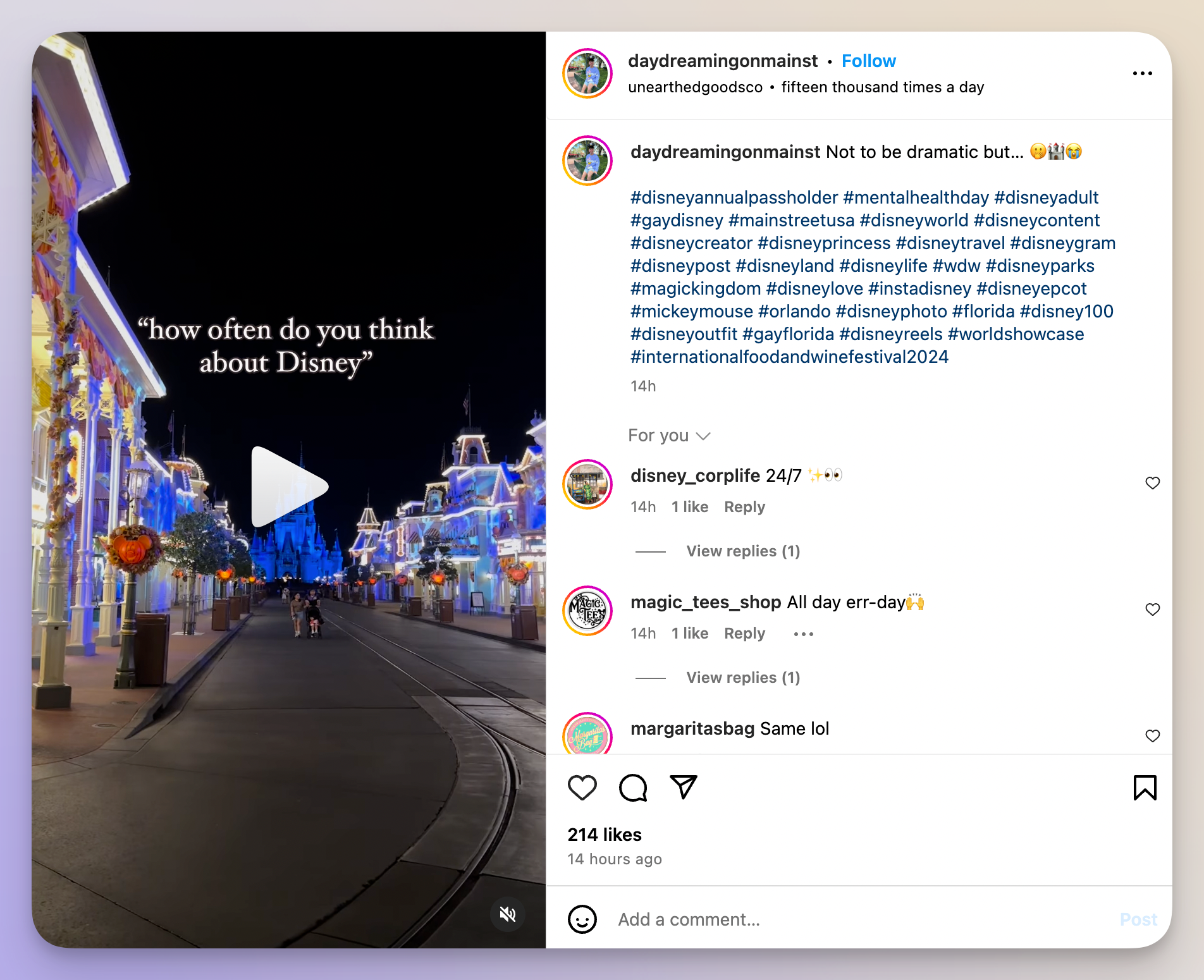
By tapping into deep-rooted emotions and shared experiences, Disney's "Disney100" campaign not only celebrated its rich history but also reinforced its timeless connection with audiences, making it a standout example of an emotional storytelling campaign.
#9. Create an opportunity to generate UGC
According to a survey by Stackla, nearly 80% of consumers reported that UGC significantly influences their purchasing decisions, making it 8.7 times more impactful than influencer content and 6.6 times more influential than branded content.
Consumers inherently trust recommendations from peers, and UGC offers a way to harness this trust while deepening the connection between your brand and its community.
A prime example is Glossier, which leverages UGC by enlisting Instagram’s leading influencers to receive prerelease products and post reviews and photos with the #glossier hashtag.
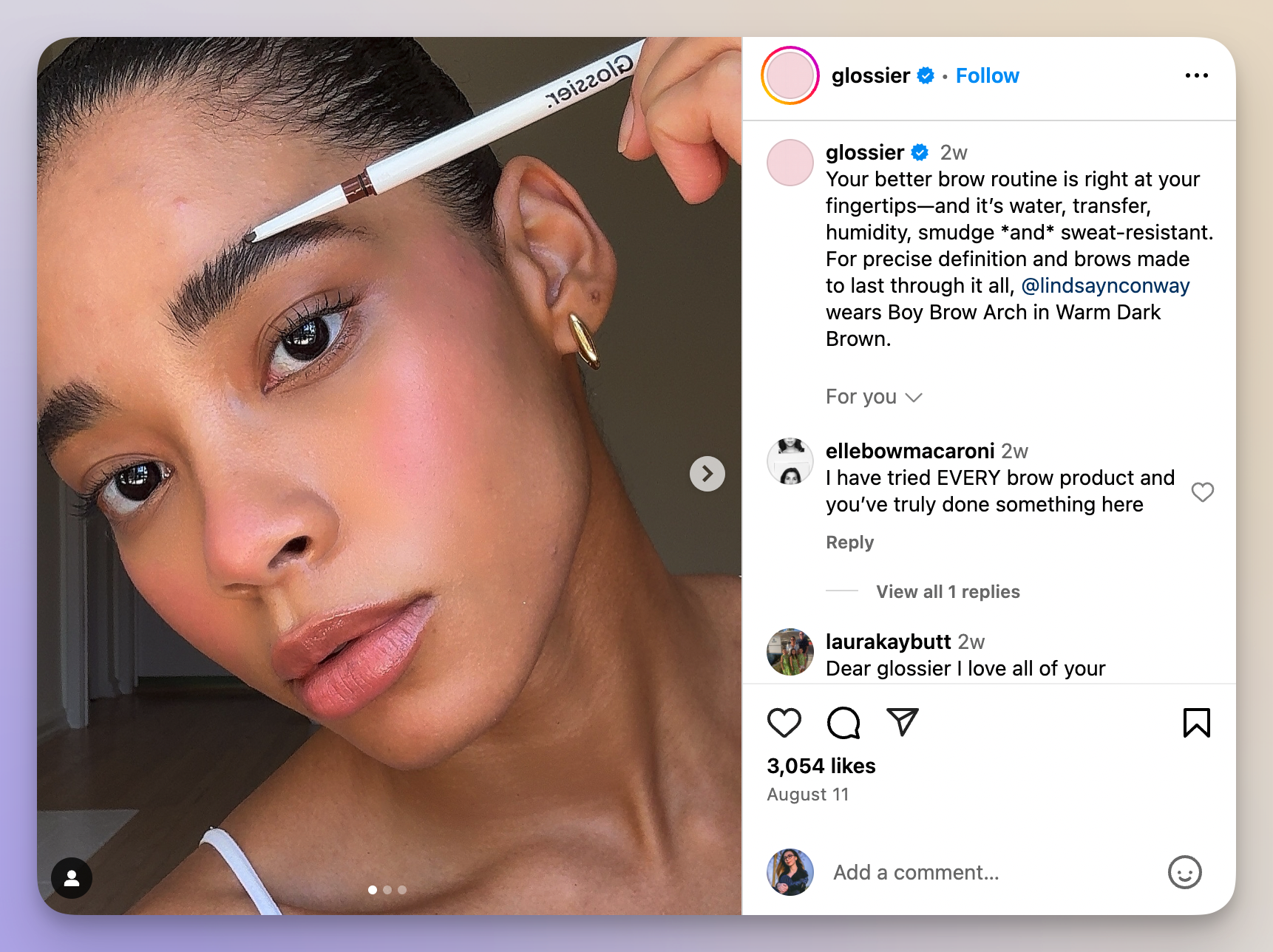
#10. Combine organic and paid content for effective social media campaigns
In a successful social media marketing campaign, organic and paid strategies should work hand-in-hand.
While organic content builds trust, credibility, and long-term engagement with your audience, paid promotion ensures that your message reaches a broader and more targeted audience quickly.
Organic content allows you to establish your brand’s voice and foster genuine connections with your followers.
It’s essential for building a loyal community that interacts with your posts, shares your content, and advocates for your brand.
When building a marketing campaign, organic content is crucial in laying the foundation for long-term brand loyalty.
However, relying solely on organic reach can limit your campaign’s potential, as algorithm changes and competition often reduce the visibility of your posts.
This is where paid social media comes in. Paid campaigns can amplify your organic efforts by boosting your content’s reach, targeting specific demographics, and driving immediate results.
For instance, promoting a well-performing organic post through paid ads can help it reach users beyond your existing followers, increasing engagement and conversions.
Integrating both organic and paid tactics into your campaign strategies ensures a balanced approach, maximizing your reach and impact while maintaining authenticity in your brand messaging.
A balanced approach, where organic content establishes your brand and paid content accelerates its reach, ensures that your campaign has both depth and breadth.
For example, Nike effectively combines organic and paid strategies. They use organic posts to showcase their brand’s authenticity and values, then amplify high-performing content through targeted ads.
This approach ensures that their message resonates with both their existing audience and a broader, targeted demographic.
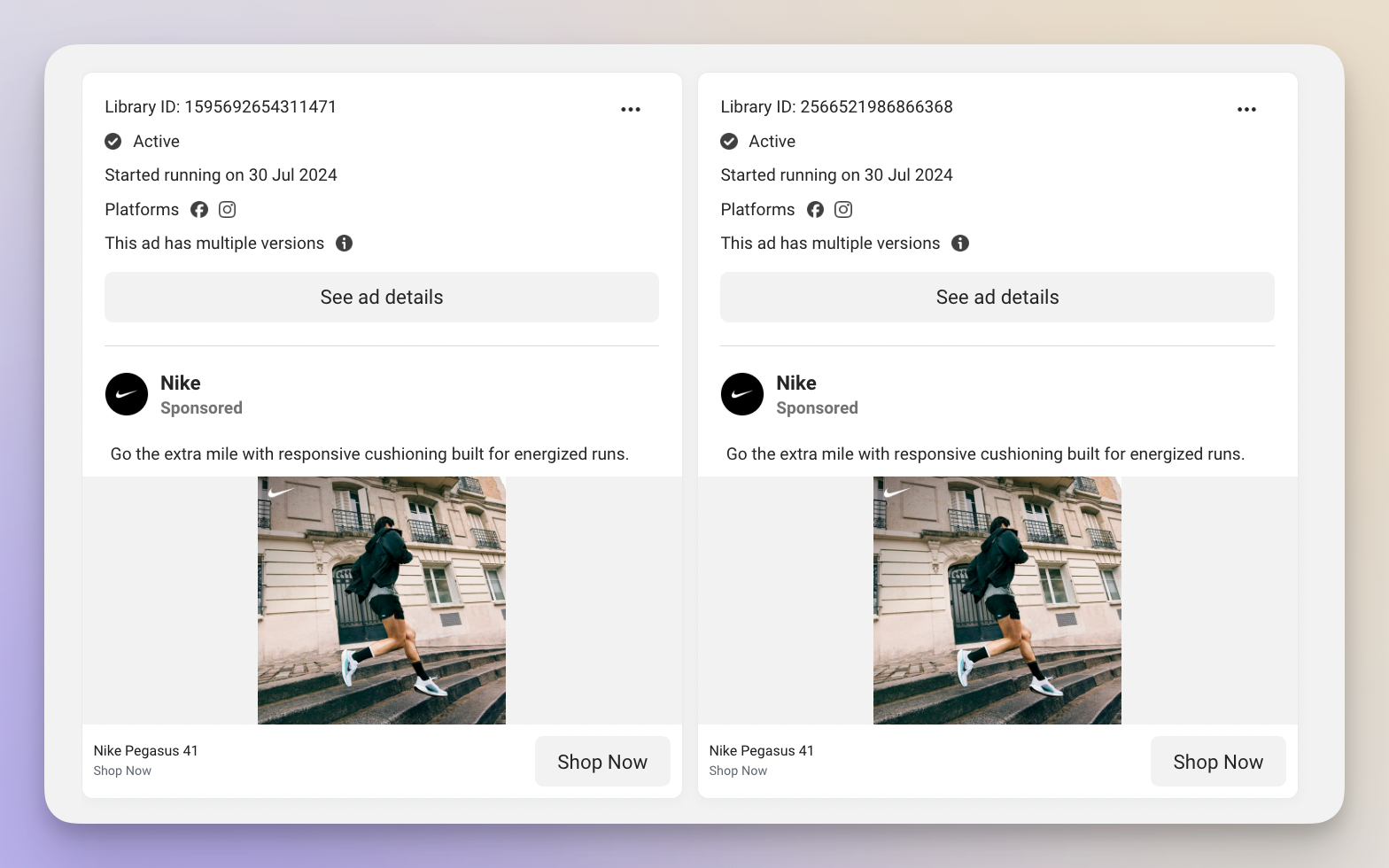
Examples of creative social media campaigns
Spotify’s Wrapped
Spotify's #Wrapped campaign is a brilliant example of personalized marketing done right.
Each year, Spotify delivers a custom report to users, summarizing their listening habits in a fun and engaging way.
Spotify highlights users' favorite songs, genres, and artists, providing valuable insights into their music preferences while creating shareable content that turns users into brand ambassadors.
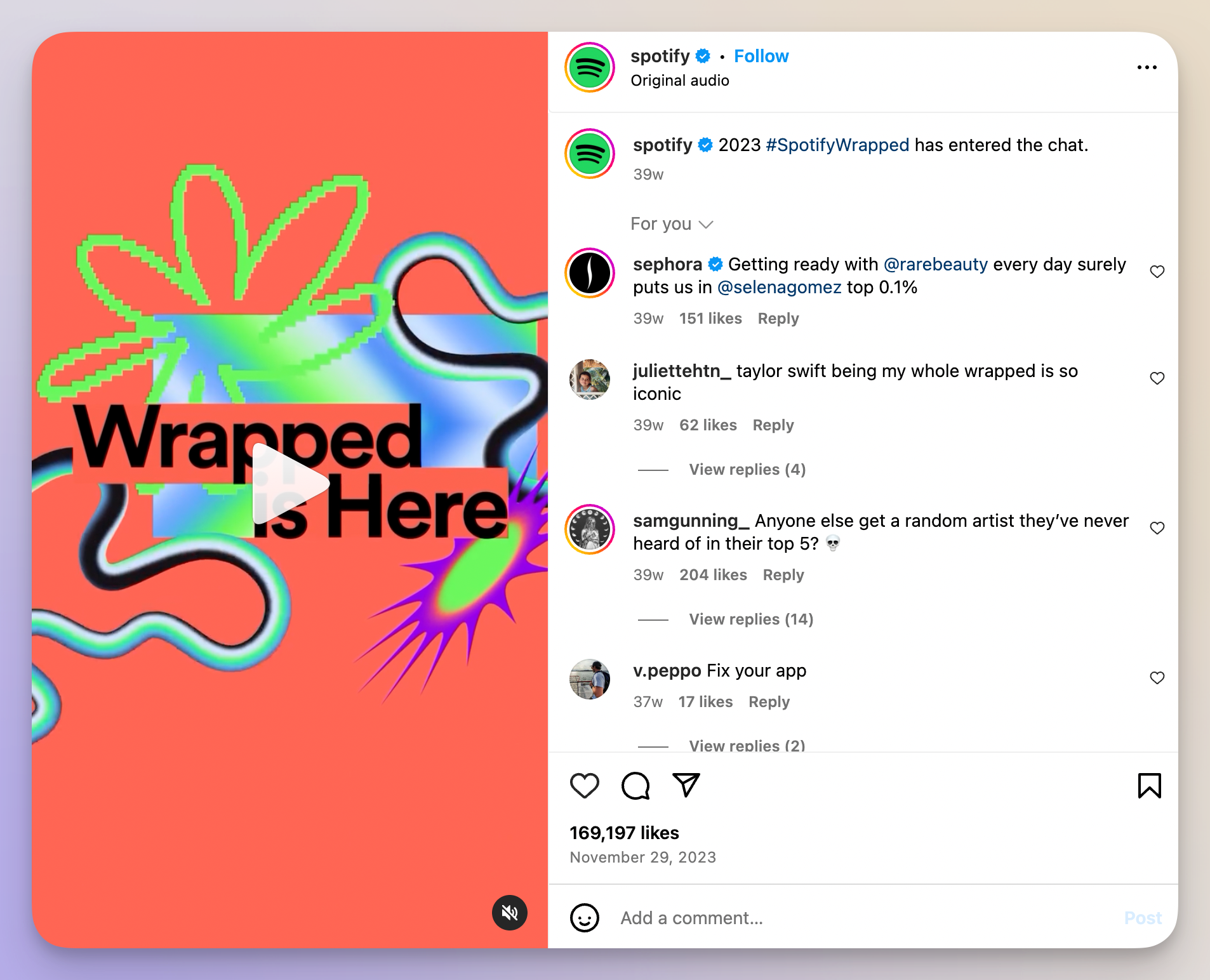
This campaign on social media is highly effective because it taps into the growing trend of personalization, making users feel special and seen.
Also, #Wrapped creates a sense of community by allowing users to compare their music tastes with friends, fostering a deeper connection with the brand.
Why we like this campaign: It’s a masterclass in leveraging data to enhance user experience. It transforms passive data into a celebration of each user’s unique musical journey, making Spotify an integral part of their lives.
The shareability of the #Wrapped results further amplifies Spotify’s reach, turning it into a viral sensation every year and reinforcing the brand’s innovative and user-centric approach.
Apple’s #ShotOniPhone
Apple's #ShotOniPhone campaign is a stellar example of blending user-generated content (UGC) with out-of-home advertising.
By inviting iPhone users to hashtag their photos for a chance to be featured on Apple billboards, the campaign turns everyday users into contributors to Apple’s global marketing efforts.
In 2022, Apple took this a step further by asking users to share their best macro photos, showcasing the latest iPhone's lens design and software capabilities. This campaign beautifully highlighted the quality of the iPhone's camera without being overly promotional, and the challenge aspect encouraged widespread participation, creating a sense of community and engagement.
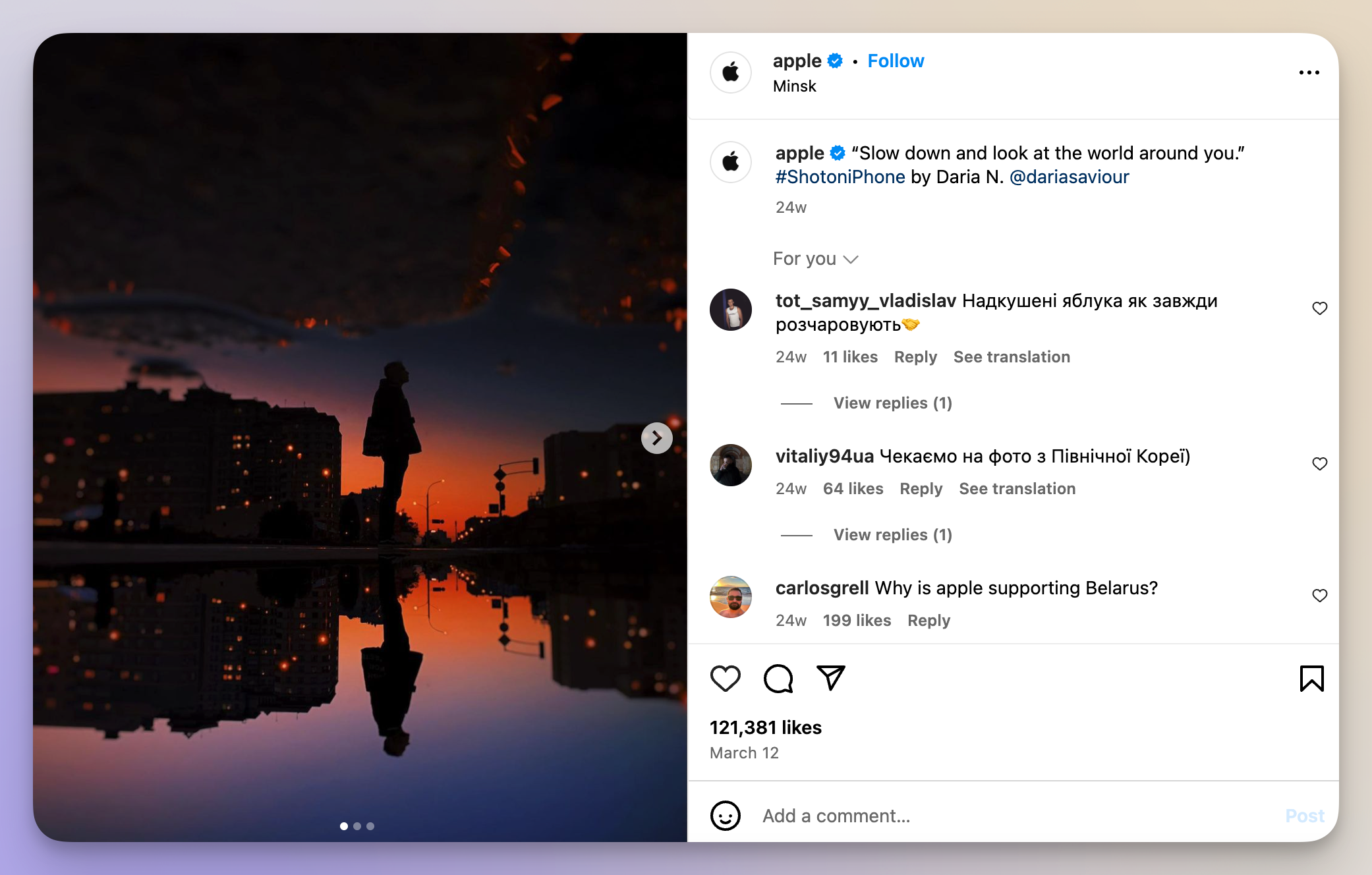
Why we like this campaign: The use of gamification, by turning photo submissions into a challenge, further boosted participation, making #ShotOniPhone not just a marketing campaign but a global movement that continues to thrive with over 29 million posts tagged on Instagram.
Warner Bros. "Barbie" Campaign
The 2023 Barbie movie by Warner Bros. was a marketing sensation, blending nostalgia with modern pop culture. Creatives kicked off more than a year before the film's release, with a teaser trailer that immediately captured attention, generating millions of social media engagements.
The campaign's strategy was not just about the movie but about making Barbie a cultural moment.
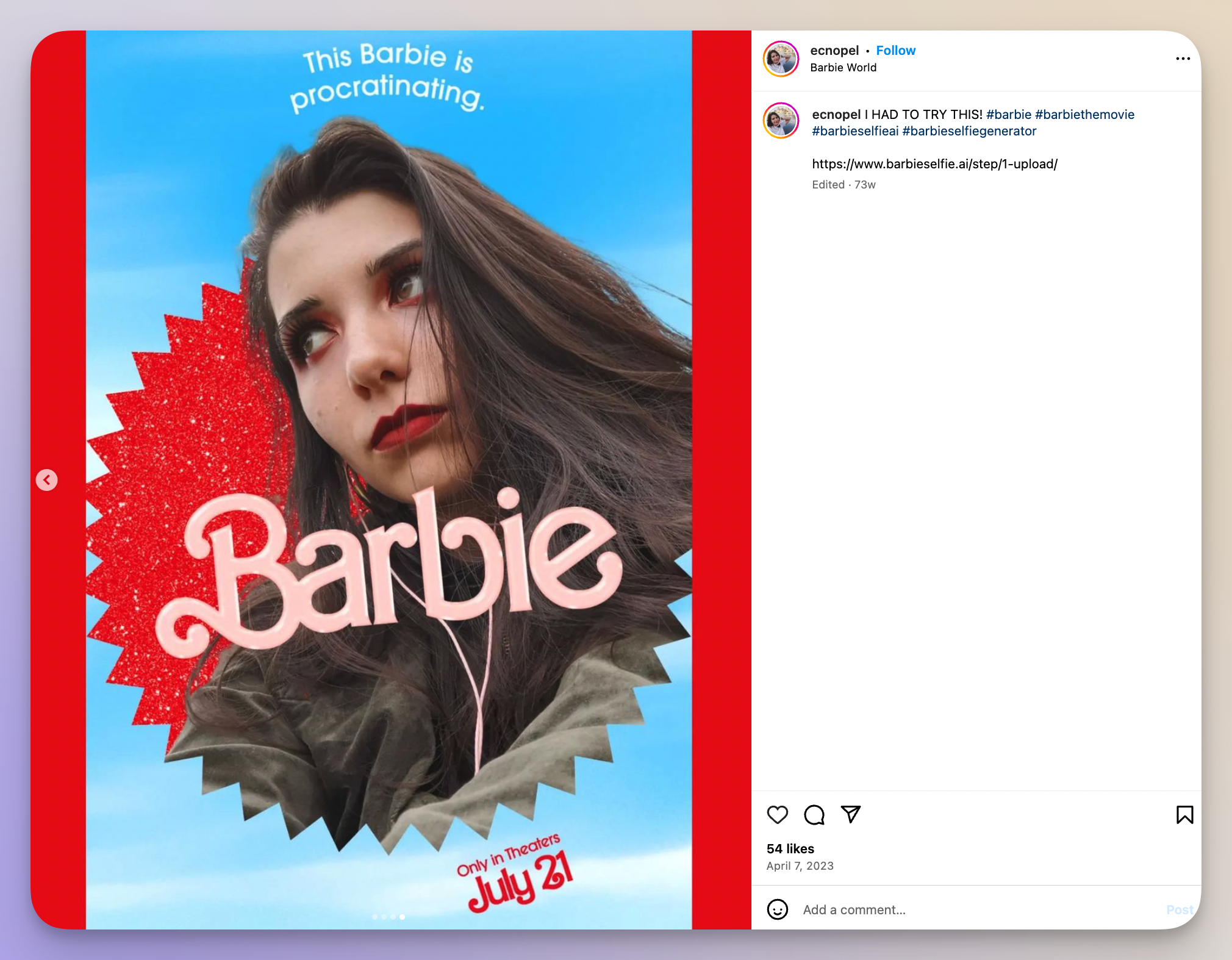
Why we like this campaign: It brilliantly combined a strong brand legacy with contemporary marketing techniques.
Warner Bros. used a "breadcrumb strategy," steadily releasing content that kept the public's interest alive.
From teaser trailers to an AI-powered selfie generator that lets fans create their own Barbie posters, the campaign leveraged user participation to amplify its reach.
The clever use of social media, including behind-the-scenes glimpses and celebrity endorsements, kept the conversation going. This multi-layered approach turned the Barbie movie into a viral phenomenon, demonstrating how to build anticipation and sustain engagement over time.
Rhode Skin’s Phone Case Launch
Rhode Skin, a skincare essentials brand, hit the mark with its recent marketing campaign, developed in collaboration with Hailey Bieber.
The brand not only highlighted its innovative and bold side, by launching an adjoining product - but also planned its reveal in great style from a marketing perspective.
At the beginning of the year, Rhode Skin introduced a unique phone case that holds lip treatments and tints as a solution to women's endless bag searching, partnering with Hailey Bieber for the product's big reveal.
Thanks to the product's cleverness and the usage of Hailey's tremendous social media audience as a product launch base, Rhode Skin quickly generated buzz on social, becoming viral.
Not only was this a clever marketing strategy, but the phone case also became a physical product available for purchase on Rhode Skin’s website, driving both brand awareness and sales.
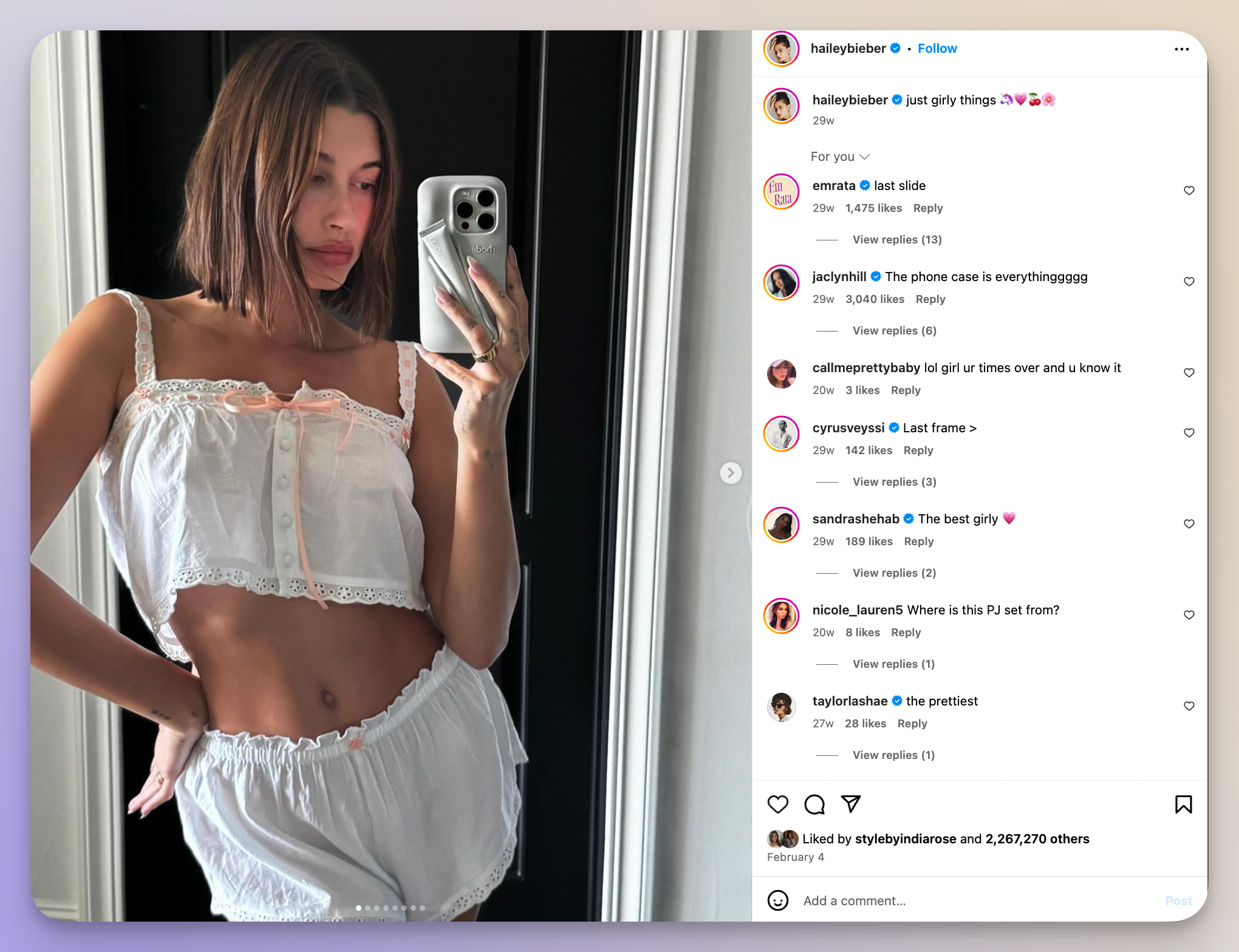
Why we like this campaign: Rhode Skin’s campaign was a success because it was unique, imaginative, and highly creative. Turning users into brand ambassadors, the brand's campaign generated massive brands awareness, while positioning the brand as a creative and helpful company.
Conclusion
Social media isn’t just full of people; it’s also full of brands and every social media manager needs to understand this.
To truly stand out, boost brand loyalty, and make people ponder about your brand, you need to give them a good reason.
When developing your social media campaign, don’t just focus on highlighting your product; instead, focus on creating an emotional connection, offering value through engaging content, and fostering a community around your brand.
Use this guide as a blueprint to craft campaigns that not only capture attention but also build lasting relationships with your audience.
FAQs on social media campaigns
How do social media campaigns help with business growth?
Social media campaigns drive business growth by increasing brand awareness, engaging with target audiences, and fostering customer loyalty. They provide a platform to reach a larger audience, promote products or services, and generate leads. Effective campaigns can also enhance customer relationships through direct interactions, leading to higher conversion rates and repeated purchases. Moreover, leveraging social media for campaigns allows businesses to gather valuable insights and feedback, helping to refine marketing strategies and boost overall business performance.








